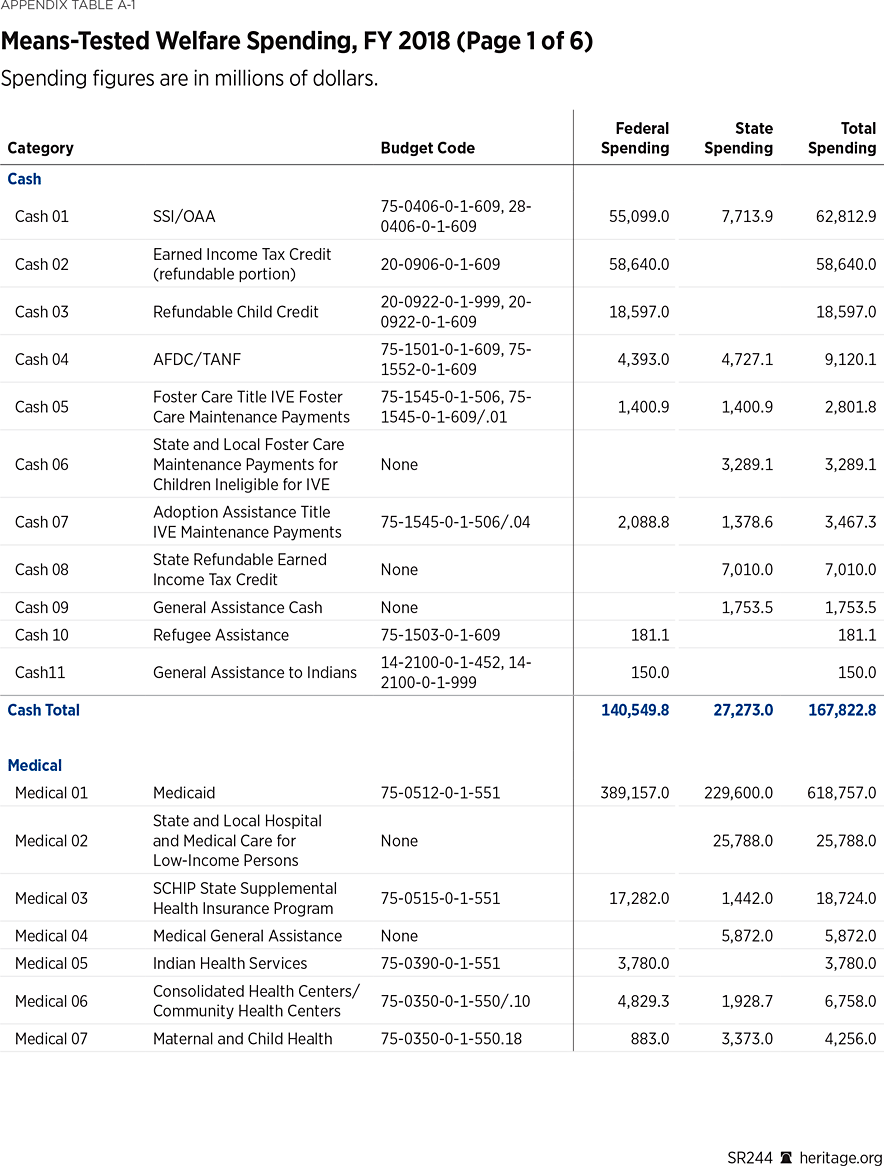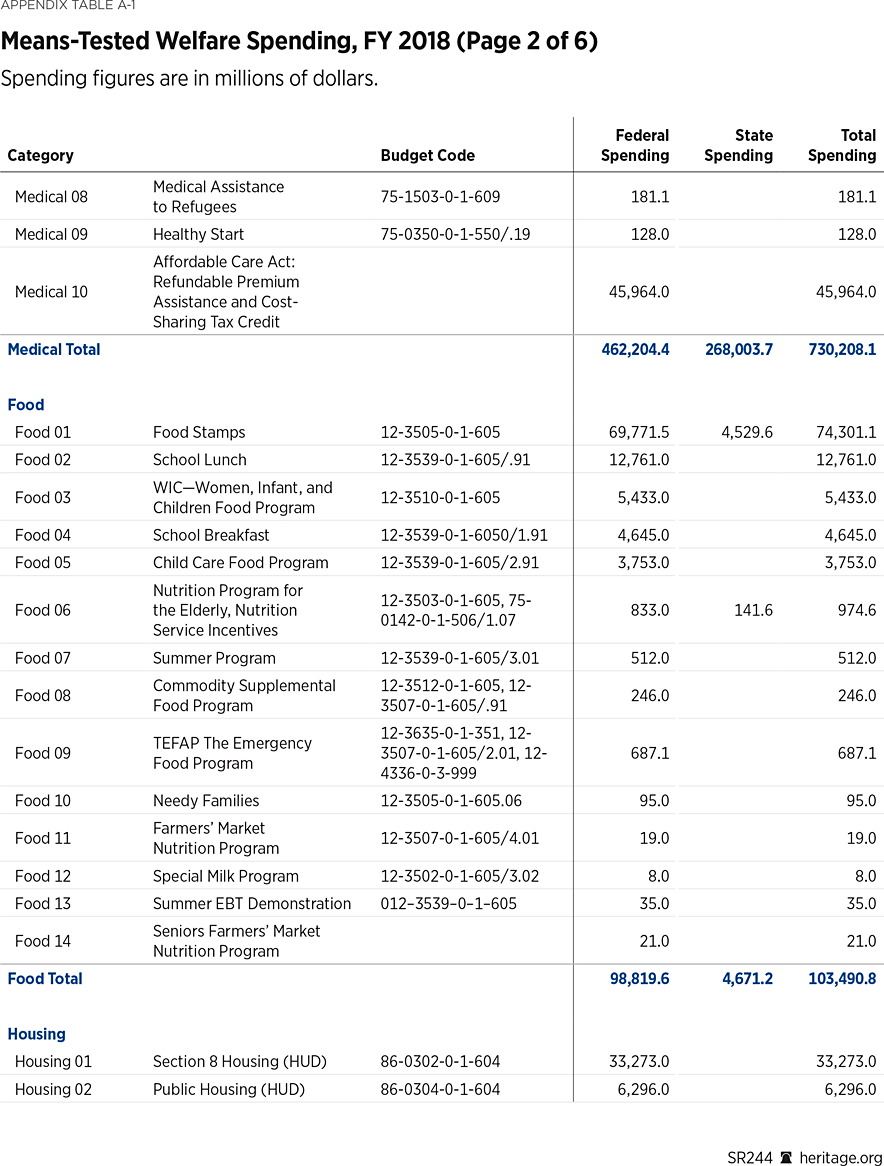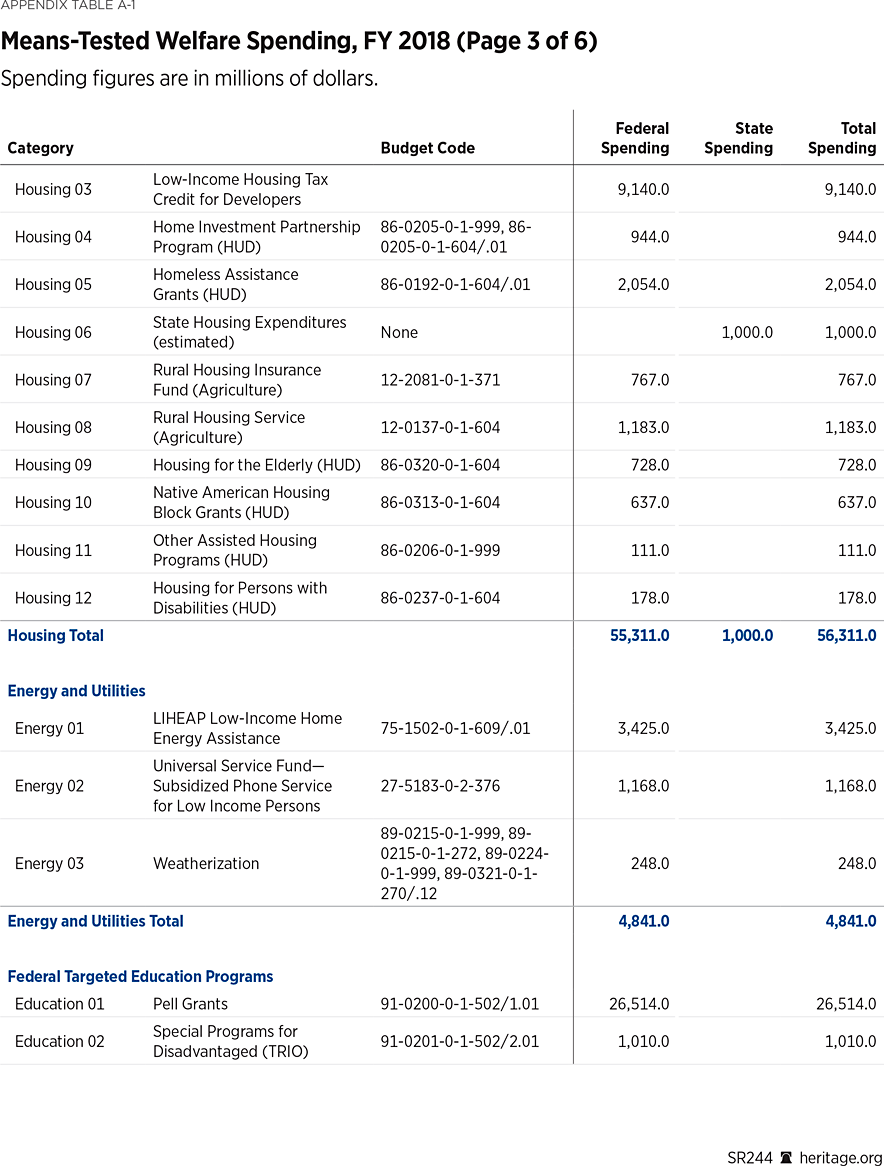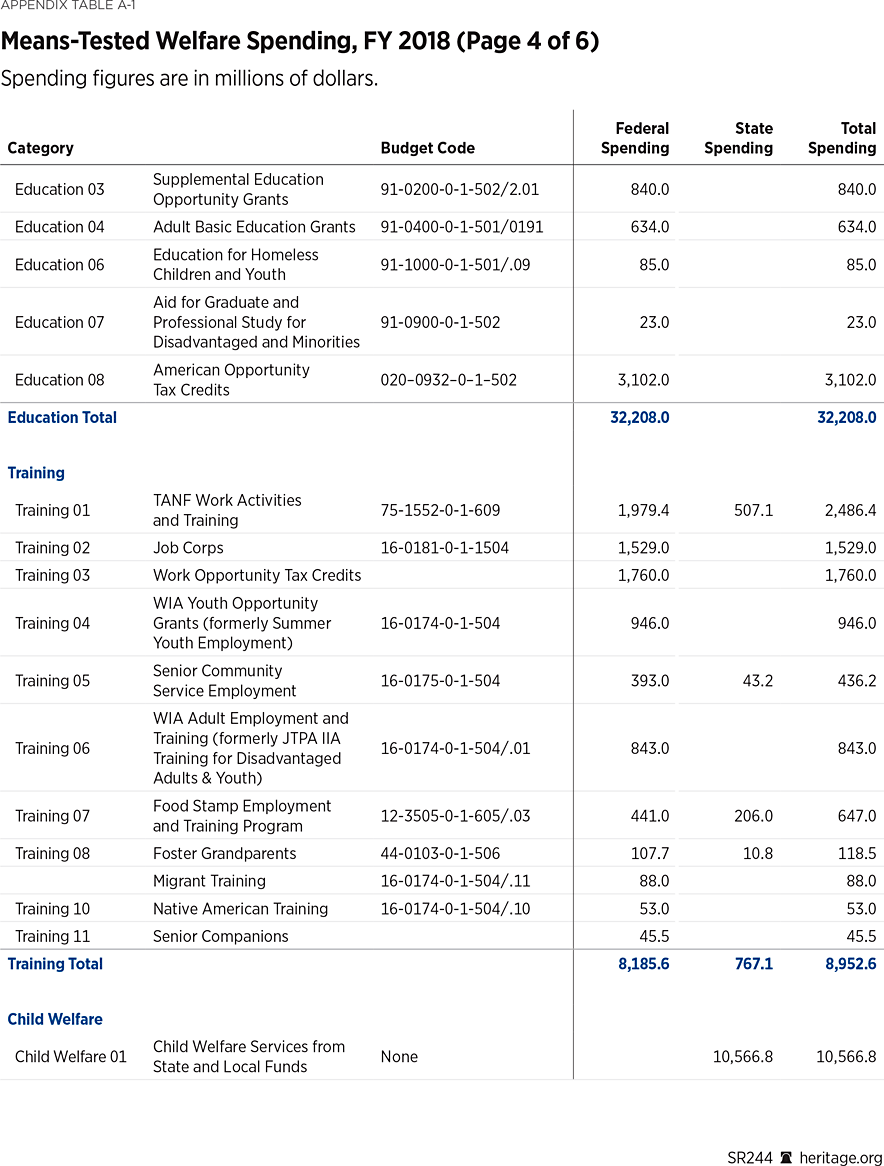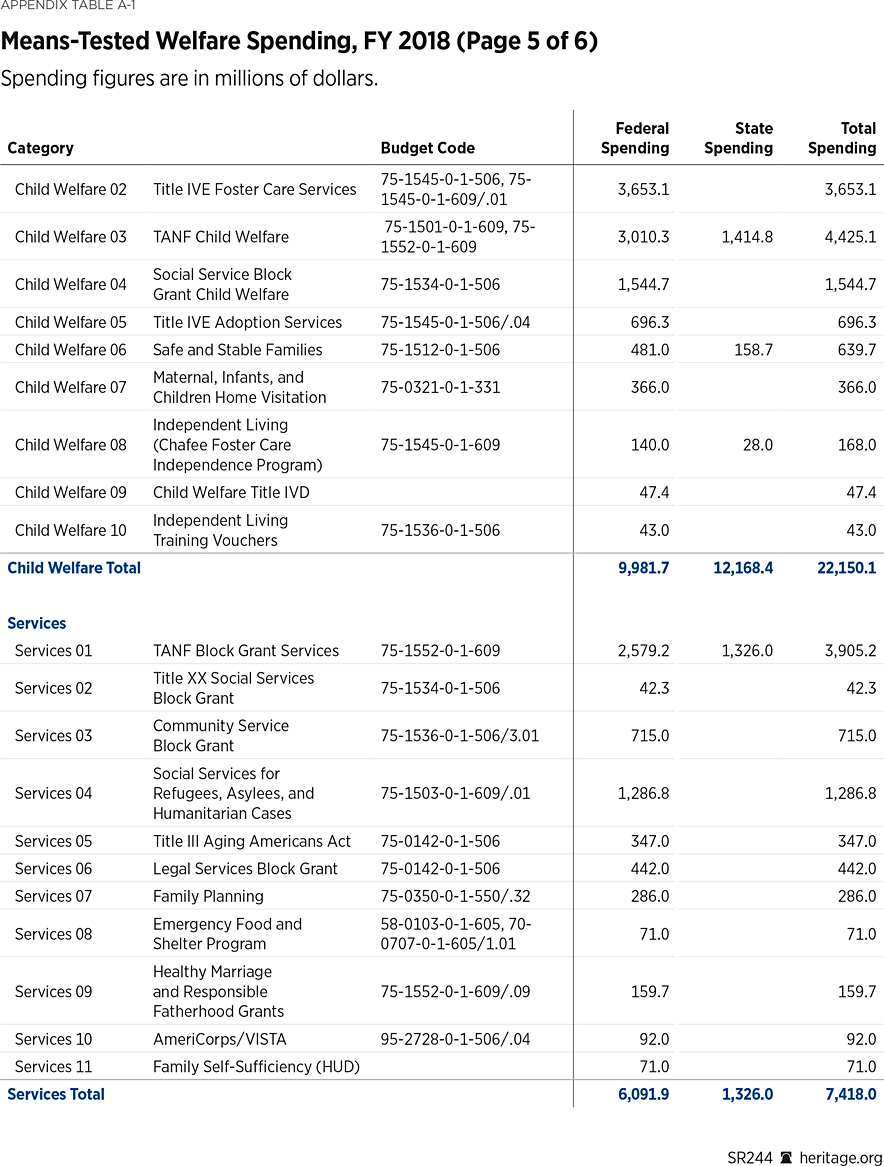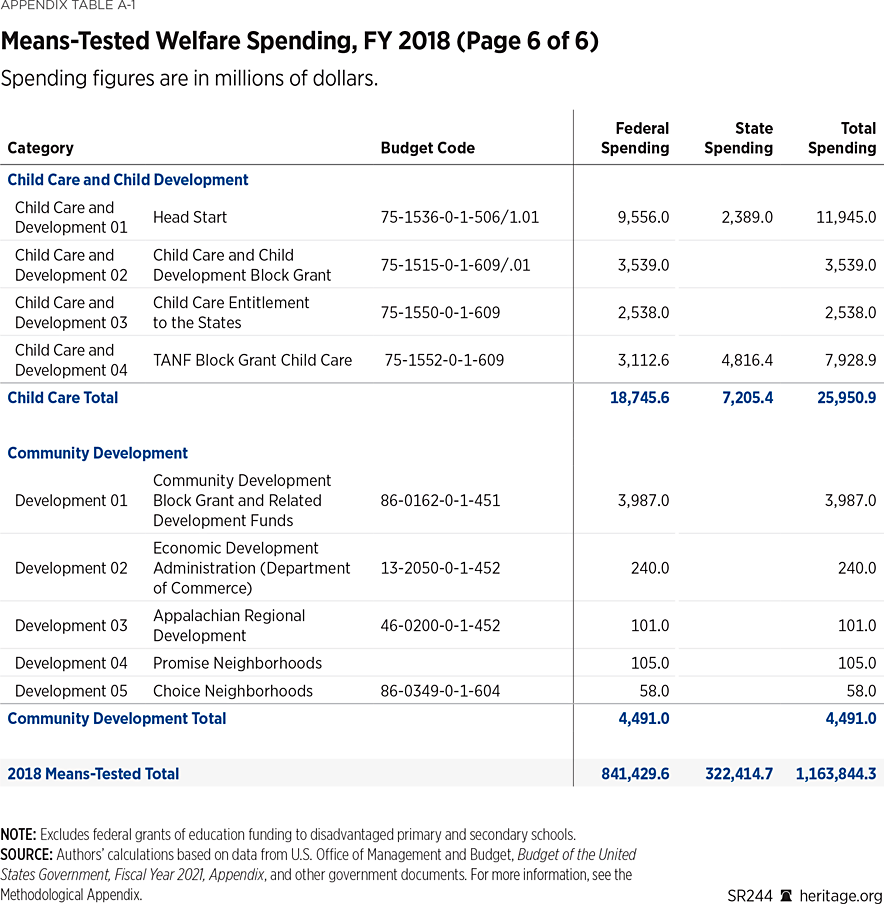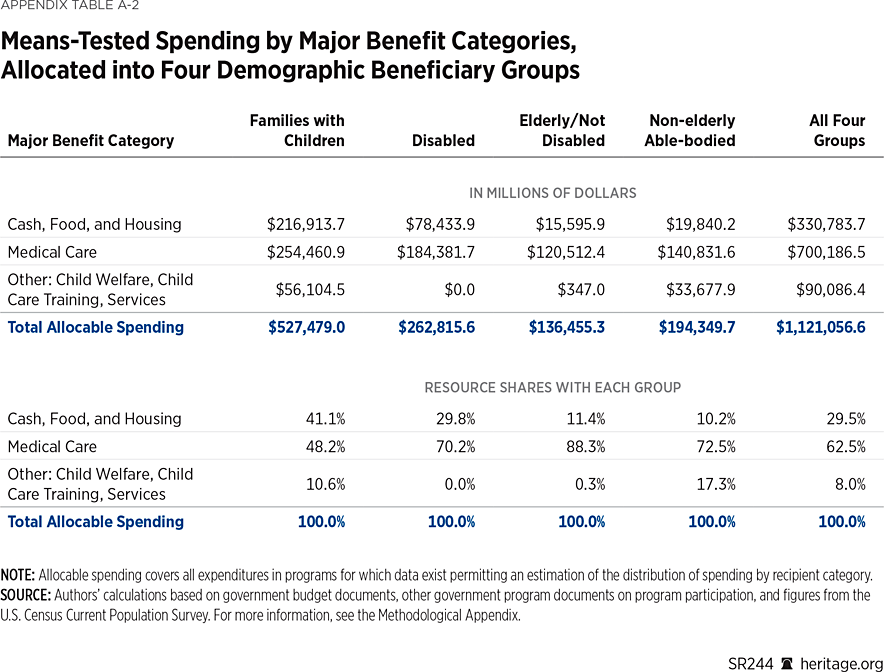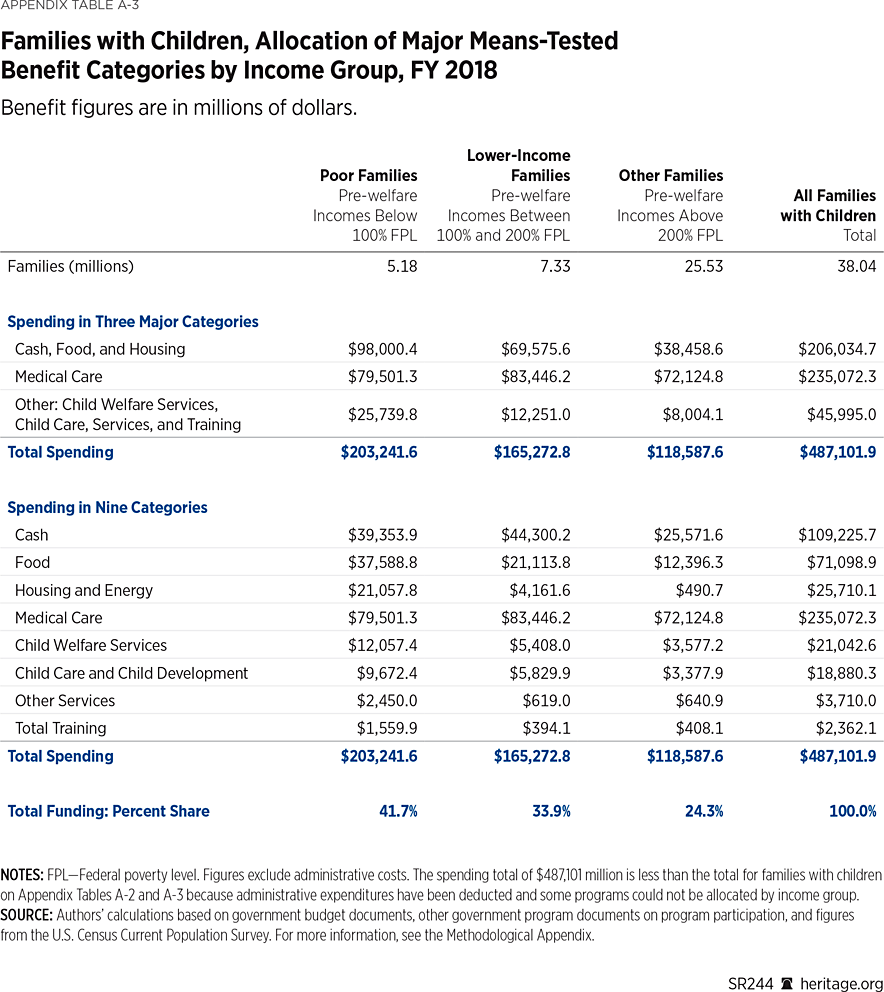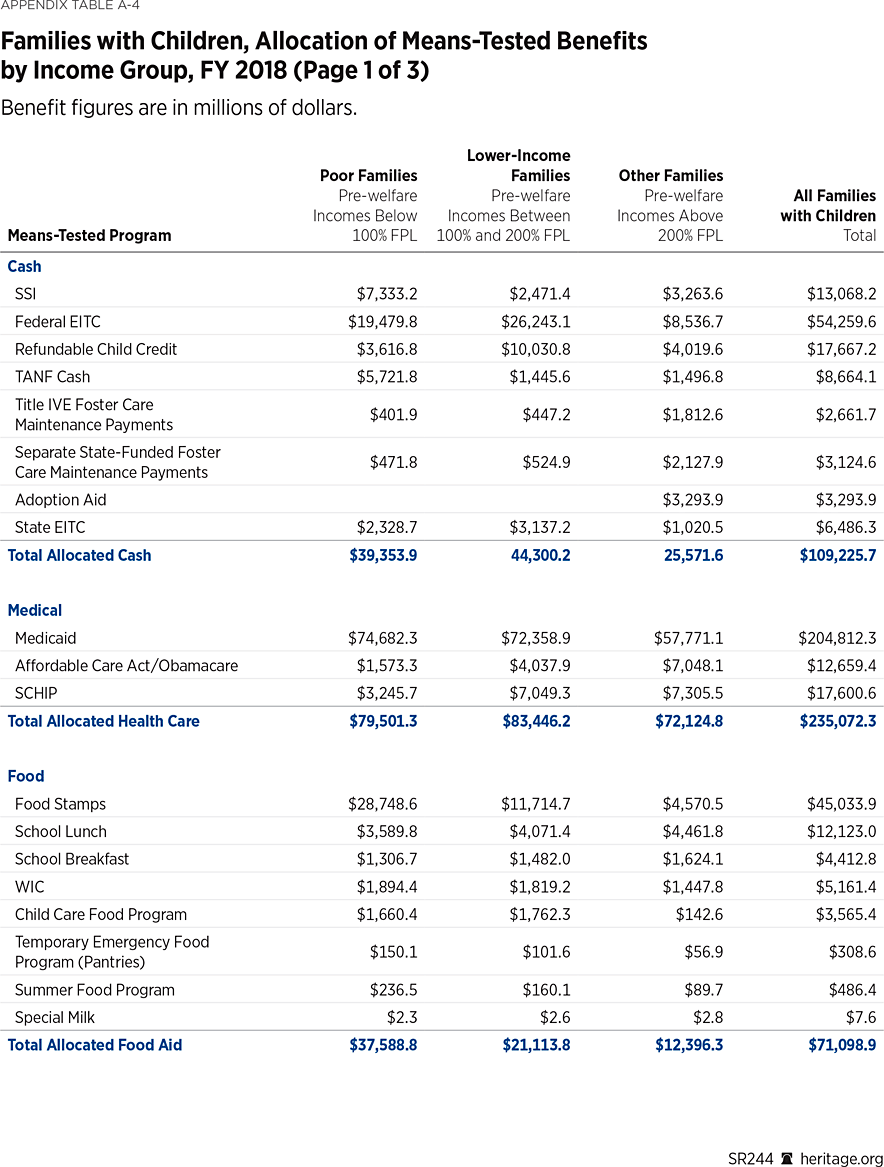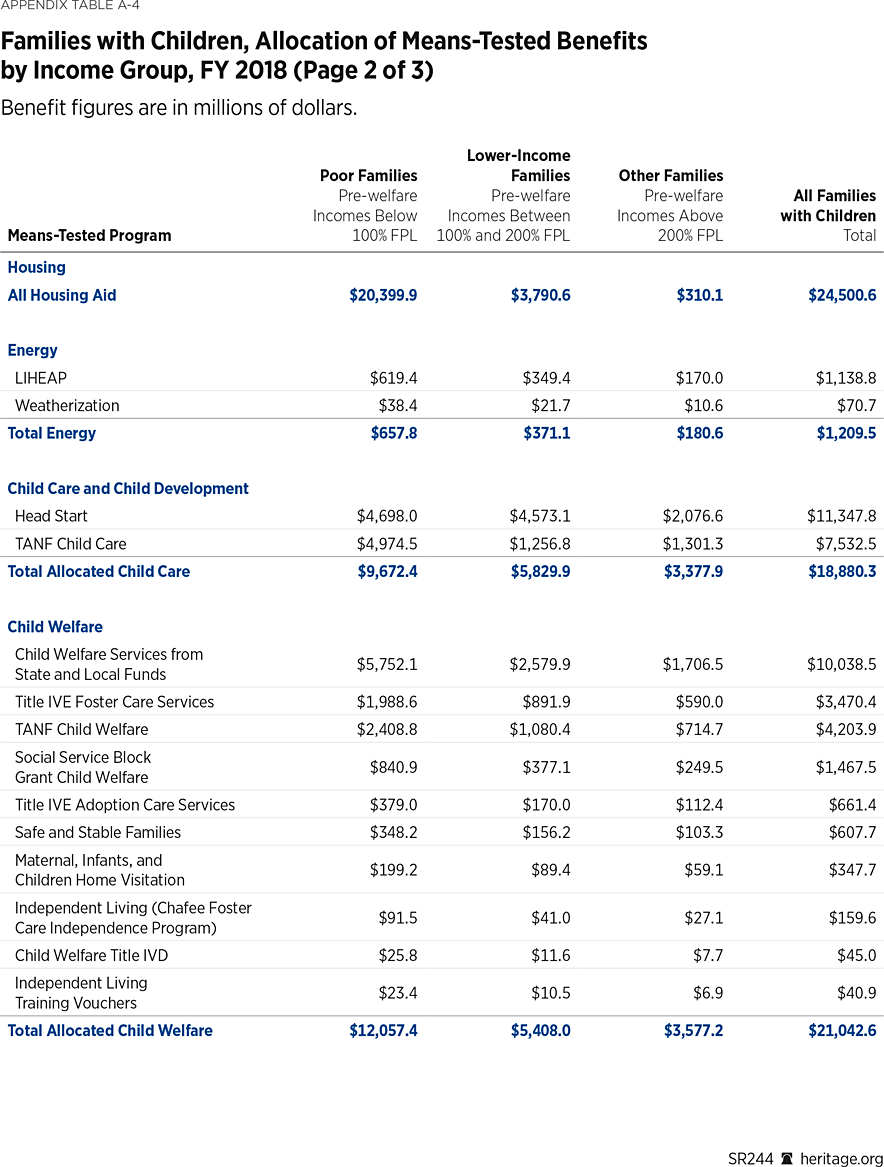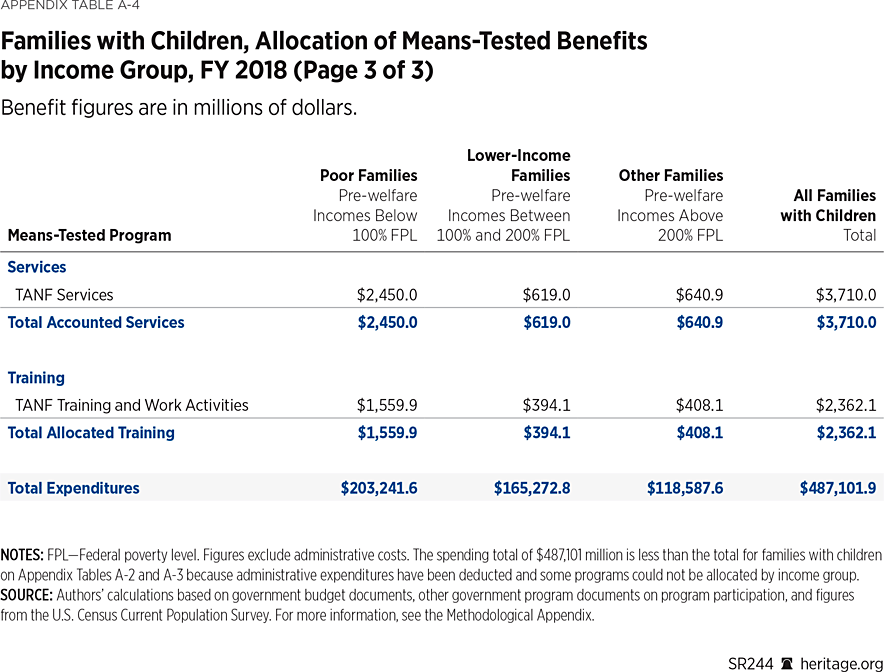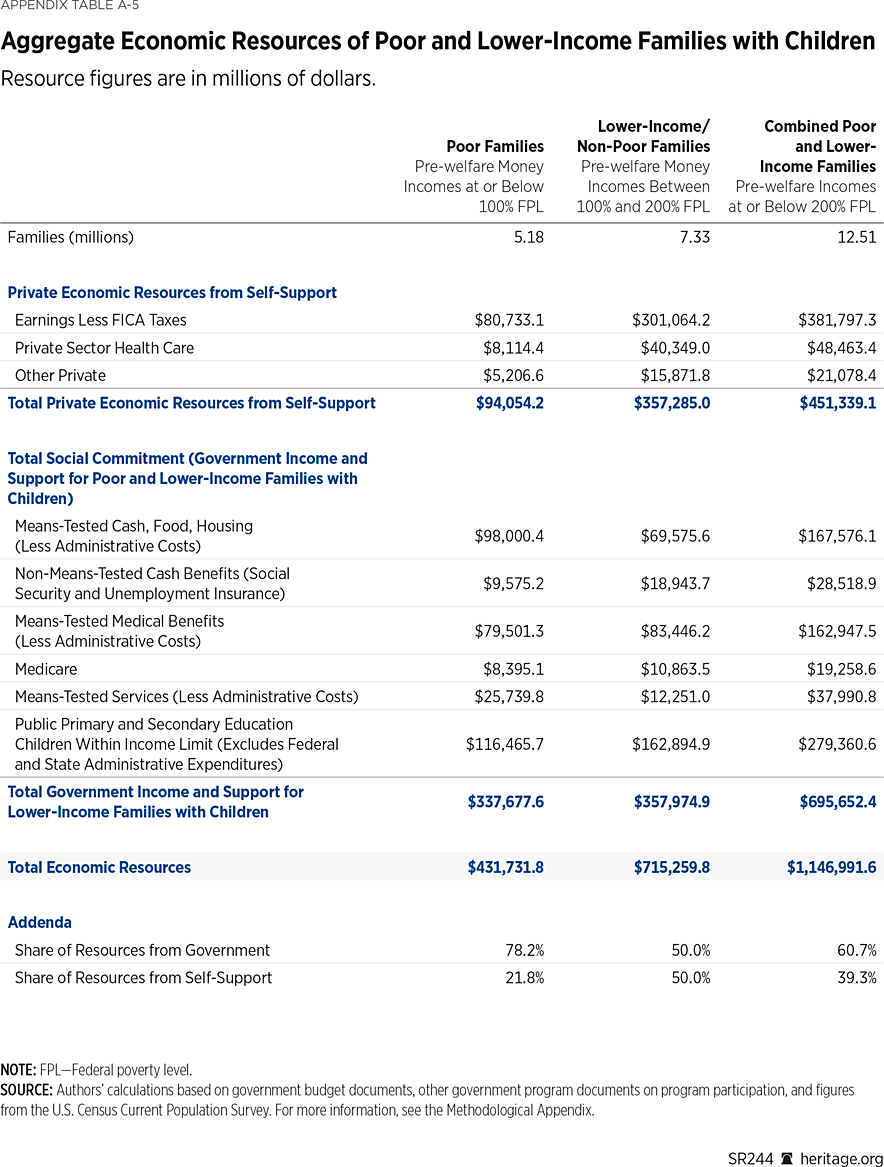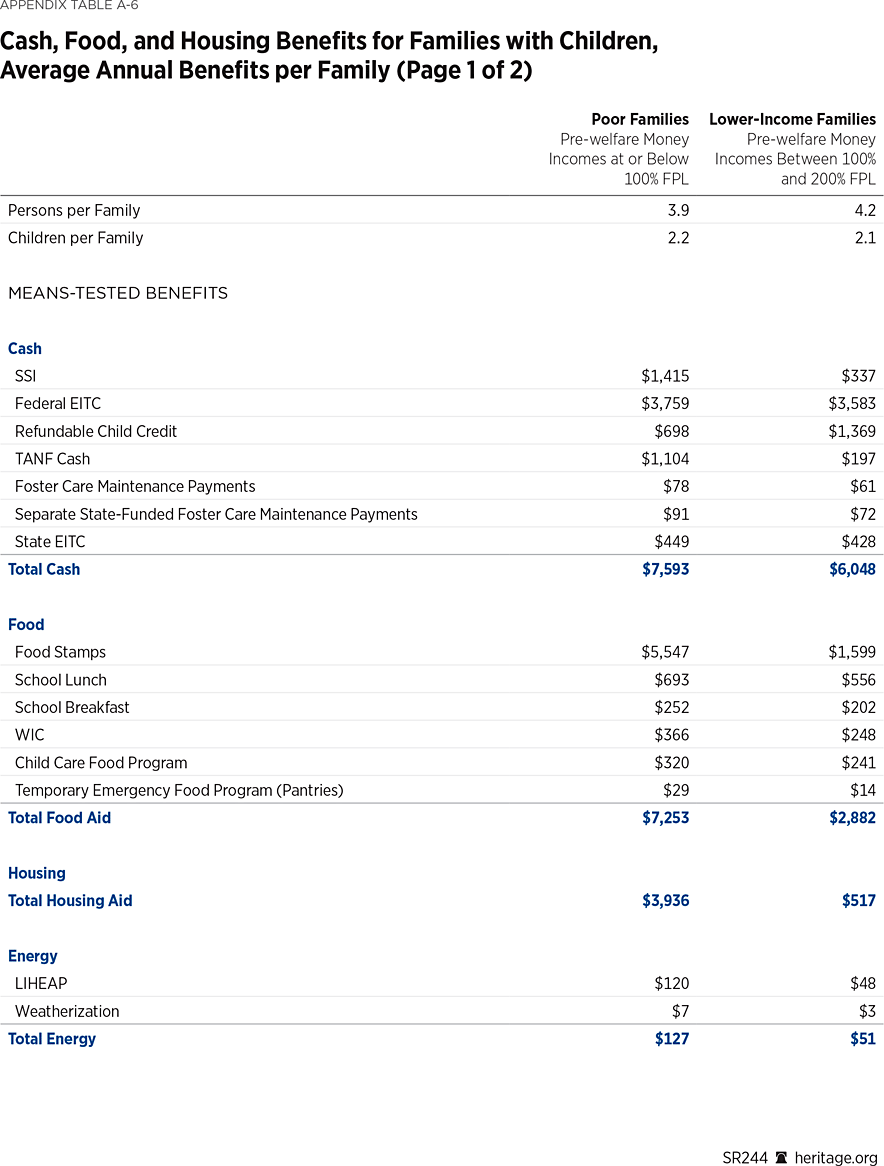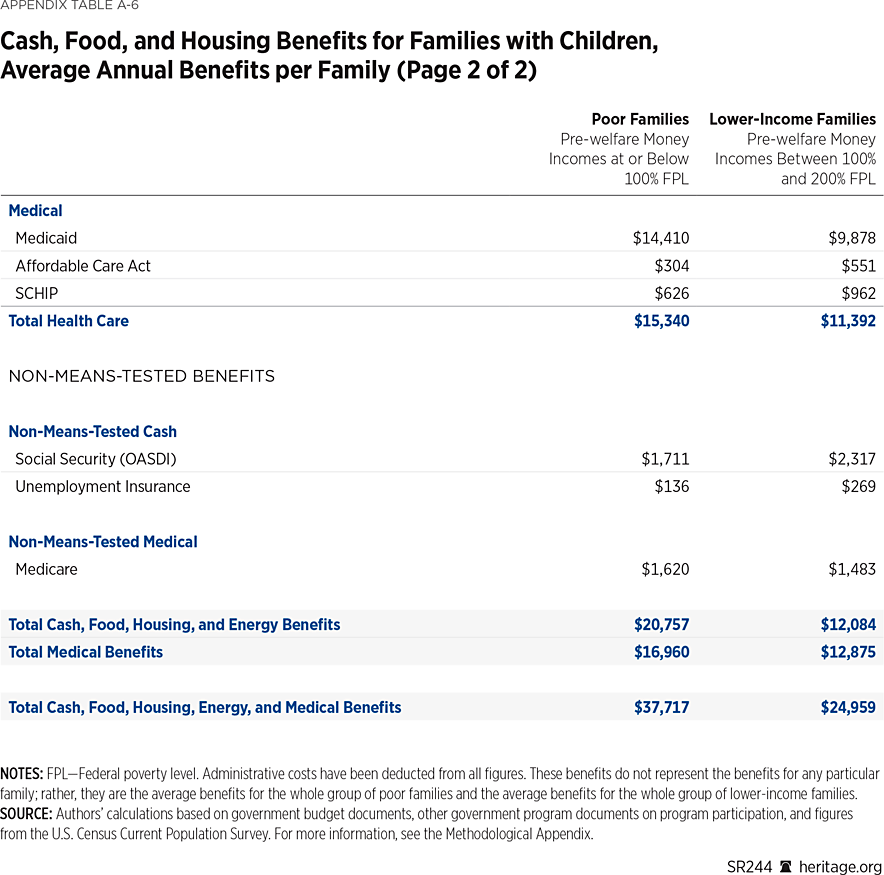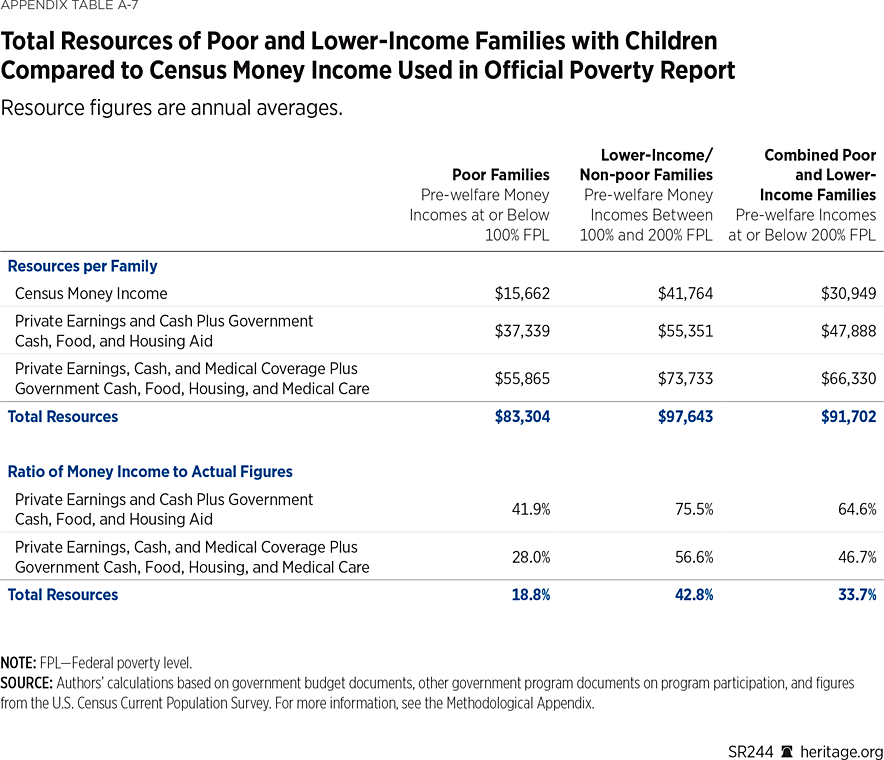Introduction
The U.S. has an extensive and heavily funded support system for poor and lower-income families with children. This total government support system consists of government spending on cash, food, housing, medical care, direct social services, and public education for those families. In 2018, before the COVID pandemic, taxpayers spent $695.7 billion on this system. The government resources received by the average family defined as poor by the government (a family that typically has two children) came to approximately $65,200 per year.REF Roughly a third of this support is in the form of government cash, food, and housing aid with a second third for medical care and a final third for education and social services.
The combined total resources of poor and lower-income families with children may be defined as their benefits and subsidies from the government support system plus any earnings and other private income obtained by the family. In 2018, the total combined resources of the average family defined as poor by the government came to $83,300 per year. Earnings plus cash aid, food and housing benefits, and medical care alone came to more than $55,900—more than twice the official poverty level for that family.
Resources vary widely across low-income families. The high average level of resources does not mean that there are no holes in the safety net and no physical deprivation in the U.S., but it does indicate that claims of widespread hunger, undernutrition, and inadequate housing are misleading.REF
Conventional reports on government spending, economic resources, and poverty are both incomplete and inaccurate. For example, each year, the Census Bureau releases an official poverty report. That report begins by ignoring all taxpayer spending on education and medical care for the poor. It also excludes nearly all government welfare programs such as food stamps, the Earned Income Tax Credit, Section 8 housing vouchers, and public housing. In 2018, out of the $378 billion that taxpayers spent on cash, food, housing, and medical benefits for poor and lower-income families, only $34.3 billion (9 percent) appeared in the Census report on official poverty. Even private earnings were substantially underreported.
Since the beginning of the War on Poverty, the U.S. has spent $34 trillion on means-tested welfare, but the Census has counted only $2.6 trillion of this $34 trillion for purposes of measuring poverty and income. From the perspective of the Census, the missing $31.4 trillion is simply “off the books.” As far as government poverty statistics go, the War on Poverty never actually happened. Because the official Census poverty report is the basis of most public discourse about poverty in the United States, it should therefore be no surprise that the extensive taxpayer support system for poor families remains largely invisible and unknown.
Massive underreporting of government support leads to the widespread misperception that the U.S. has a meager welfare state. The Biden Administration has capitalized on this misperception to demand the largest expansion of means-tested welfare in U.S. history. The President’s welfare expansion is embodied in the proposed Build Back Better Act. A revised version of this bill was introduced in the House in late October, further revised in early November, and is slated for inclusion in the partisan reconciliation proposal in Congress.
The revised bill would increase spending on low-income families with children by at least $650 billion over the next five years.REF Under the President’s proposal,REF government benefits for the average poor family with children will be increased by nearly $11,300 per year. This would include an annual increase of $9,300 in cash, food, and housing benefits combined with $700 in new medical benefits and $1,300 in child care and education spending for low-income children.
Cash, food, and housing benefits plus earnings and other private cash income for the average poor family already totaled $37,300 in the pre-COVID era. Adding $9,300 in new cash, food, and housing benefits would bring these resources to $47,600 per year—almost twice the current poverty level for the average poor family.REF
Total government spending on the average poor family will rise from $65,200 per year to more than $76,400. When limited private earnings are added to this massive government spending, combined total resources will reach nearly $94,600 per year for the average poor family.
The Build Back Better plan also eliminates the work requirements from one of the government’s largest means-tested cash programs. The plan creates a completely new system of unconditional cash grants for families that choose not to work during the year. In making this change, the Biden plan overturns on a narrow partisan basisREF the fundamental principles of the bipartisanREF work-based welfare reform from the Clinton era. That earlier reform was rooted in the concept that welfare should not be a one-way handout. Instead, welfare assistance should be based on reciprocal obligation: Society should support those who need assistance, but able-bodied recipients of aid should be required to work or at least prepare for work in exchange for the aid given.
The Build Back Better bill would restore the foundation of the pre-reform welfare system: unconditional cash grants to those who do not work. Taxpayers would be required to pay larger sums to support welfare recipients, but recipients would have no reciprocal obligations.
Shifting the welfare state in this direction is likely to undermine work and marriage in the long term. The flow of taxpayer funds to disadvantaged families will increase greatly, but many of these families are likely to become trapped at the social margins. Overwhelmingly dependent on taxpayer funding and isolated from the cultures of work and marriage, these families likely will suffer a decline in overall well-being and upward mobility, repeating patterns seen before the 1996 welfare reform required welfare recipients to work in exchange for benefits.REF
A sound welfare system should begin with an accurate assessment of the total taxpayer resources devoted to supporting the poor and the actual economic resources currently available to poor families. This information is lacking in the current system.
Any welfare system should be based on balanced, reciprocal obligations. Able-bodied recipients should be expected to contribute something back for the very large level of taxpayer support they receive. Finally, the welfare system should be designed so that it strongly promotes work and marriage. Not only are these the most efficient roads out of financial poverty; they also provide strong intrinsic rewards in themselves, increasing personal, familial, and social well-being.REF
Total Resources
This paper examines the total resources received by or spent on behalf of poor and lower-income families with children in the U.S. The concept of total resources represents a holistic measure of funds utilized to meet medical needs, educational needs, and physical needs and wants. Within this context, the paper focuses on five measures:
-
Government resources are the fiscal resources devoted by federal, state, and local governments to meet the physical, medical, and educational needs and wants of families with children.REF Specifically, this means government spending to provide cash, food, and housing benefits as well as medical care, direct social services for the family, and public education for the children.
-
The total lower-income government support system represents all taxpayer funding channeled to meet the medical, educational, and physical needs and wants of poor and lower-income families with children.
-
Self-support resources are the resources a family itself provides to meet needs and wants. These resources include primarily earnings, but they also include business income, asset income such as interest and dividends, and employer-provided medical insurance.
-
The combined total resources of a family represent the sum of the government resources and self-support resources provided directly or indirectly to the family.
-
The self-support ratio represents the ratio of self-support resources of a family as a share of their combined total resources.
This focus on total resources is much broader than the scope in the official poverty measure (OPM) reported by the government.REF The official poverty report focuses on physical needs and wants and counts only a portion of the cash income received by families.REF Limiting the focus to cash benefits (or even to cash, food, and housing benefits) greatly understates the actual fiscal commitment of U.S. taxpayers in support of the poor.
A limited focus on cash or cash-like benefits inverts the policy priorities of the public and most policymakers. Actual public policy places a very high emphasis on providing free primary and secondary education and free medical coverage to low-income families with children. It places much less emphasis on guaranteeing cash and cash-like transfers. Focusing exclusively on cash, food, and housing aid while excluding free education and medical care dramatically understates and distorts the actual taxpayer commitment to the poor. The measurement of total resources presented in this paper offers new insights; it complements but does not replace the measurement of physical poverty and deprivation.
Finally, the holistic approach to resources raises questions concerning the balance of obligations. To what extent, if any, should the parents in low-income families be expected or required to contribute to the support of their families? While it is clearly necessary and appropriate to provide generous assistance to poor families, should the obligation to support be placed on the taxpayers alone, or should the parents also be required to contribute at least something to the support of their families?
This question of the balance of obligations has gained salience recently through the efforts of the Biden Administration to remove or weaken work requirements through much of the welfare system.REF
The rest of this paper is divided into seven sections that demonstrate a picture of resources available to low-income Americans that is more comprehensive than the one captured in official measurements.
- The first section discusses the means-tested welfare system as it affects families with children. This system is the largest source of resources for poor and lower-income families with children.
- The second section broadens the scope of the resources discussed beyond means-tested welfare. Total resources to families are defined as resources coming through five channels: private income from earnings and other sources; government cash, food, and housing benefits; government-funded medical care; means-tested subsidies for direct services such as child care, child welfare services, and training; and the taxpayer cost of public education provided to children in low-income families.
- The third section defines poor and lower- income families with children and describes the total governmental and non-governmental resources available and provided to these two groups.
- The fourth section discusses the dramatic undercount of resources in the Census measure of official poverty.
- The fifth section discusses the difference between the measure of physical poverty and the measure of total resources and how these two measures can complement each other. It also discusses improvement of the poverty measure.
- The sixth section describes the proposed spending in the revised Build Back Better bill. It describes the new benefits and resources the bill would provide to poor families with children and what the total resources of those families would be if these new resources were added to the existing resource base.
- The concluding section summarizes the material presented in the report.
Section 1: Means-Tested Benefits and Families with Children
Government means-tested aid programs provide the largest channel of economic resources to poor families with children. Means-tested programs differ from most other government activities. While most government programs provide benefits and services across all citizens irrespective of economic class, means-tested welfare programs provide benefits exclusively to persons with lower incomes. Means-tested aid programs use taxpayer resources to pay for the cash items, food, housing, services, and medical care consumed by lower-income families because those families lack the earned income to pay fully for that consumption themselves.
While it is commonly believed that the United States has a meager welfare state, the means-tested welfare system is in reality quite large. It is comprised of 89 federal and state programs that provide cash, food, housing, medical care, and social services exclusively for poor and lower-income persons.REF Major means-tested programs include cash grants in the Earned Income Tax Credit (EITC) and the Additional Child Tax Credit (ACTC); Supplemental Security Income (SSI); Temporary Assistance for Needy Families (TANF); Medicaid; the Children’s Health Insurance Program (CHIP); subsidies from the Affordable Care Act (ACA); food stamps; the Women, Infants, and Children (WIC) food program; school nutrition programs; public housing; Section 8 housing; the Child Care and Development Block Grant (CCDBG); and many others. (Social Security and Medicare are not means-tested and are not included in the means-tested spending totals employed in this paper.)
In 2018, before the COVID-19 pandemic, federal and state governments spent $1.16 trillion on means-tested aid programs. Approximately 73 percent of this spending came from the federal government and 27 percent from state governments. (For a list of all means-tested programs and spending covered in this paper, see Appendix Table A-1.)
Most means-tested programs have a benefit gradient that provides a maximum benefit to an individual or family with zero income and then incrementally reduces the benefit as income or earnings rise. Benefits per family become smaller as other incomes rise until the benefits reach zero. The income level at which benefits fall to zero can be called the benefit termination point. Families with incomes above the benefit termination point will not receive benefits.REF
This gradual reduction in benefits means that spending can extend fairly high up the pre-welfare income range before the benefit termination points are reached.REF Individual programs are also designed to complement each other by providing similar benefits at different income levels; for example, the subsidies under the Affordable Care Act generally become available at the income range where eligibility for Medicaid benefits ends. Similarly, EITC benefits increase in value across the income range where food stamp benefits fall. As a result of these factors, means-tested benefits are available at higher levels of pre-welfare income than one might suppose.REF
Of the $1.16 trillion in total means-tested spending in 2018, $527.5 billion was spent on families with children.REF (See Appendix Table A-2.) Of this sum, $216.9 billion was for cash, food, and housing benefits; $254.5 was for medical care; and $56.1 was for services.
Section 2: Channels of Resources
Broadly speaking, there are five channels of resources that are received by or spent directly on behalf of poor families with children:REF
-
Private income. This is predominantly the post-tax cash earnings of parents, although it also includes small amounts of employer-provided health insurance and property income such as interest on savings.
-
Government cash, food, and housing benefits. This resource consists primarily of aid provided by a broad array of means-tested welfare programs such as food stamps, cash grants from the EITC, and Section 8 housing vouchers.
-
Government-funded medical care. This consists primarily of government payments through means-tested medical programs such as Medicaid, the Children’s Health Insurance Program, and subsidies provided through the Affordable Care Act.
-
Government means-tested subsidies for direct social services. This resource consists primarily of means-tested subsidies for child care, child welfare services, and job training.
-
Public education spending on low-income children. This is the cost per pupil of public primary and secondary education for children in poor and lower-income families. This cost is borne primarily by general taxpayers since poor parents pay little in taxes to fund the service.REF
Detailed Channels of Economic and Social Resources. In general, resources come to lower-income families with children through these five major channels, but detailed analysis can break these channels down into at least nine subcategories:
-
Earned income. Earnings and the lack of earnings are important factors in separating poor and non-poor families. All earnings figures used in this paper are net of FICA taxes.REF
-
Property income. Poor and lower-income families with children report a small flow of “non-earned” cash income from interest, dividends, property, and business income and similar sources.
-
Employer-provided health insurance. Some poor and lower-income parents have jobs with employer-provided health coverage.
-
Means-tested cash, food, and housing benefits. These government benefits are delivered to lower-income families with children through major programs such as the EITC, Child Credit cash grants, TANF, food stamps, the WIC food program, child nutrition programs, Section 8 housing and public housing, and dozens of smaller programs.
-
Government non-means-tested cash. A few poor and lower-income families with children also receive cash benefits from programs that are not means-tested. The most important of these programs are Social Security and Unemployment Insurance.
-
Government means-tested medical benefits. The government pays for low-income persons’ medical care through a system that is both diverse and complex. In most states, families with children with incomes below 138 percent of the official poverty measure poverty thresholds are entitled to free or nearly free medical care through the Medicaid program.REF Some of the families who are eligible for Medicaid are not actively enrolled; however, this is not a barrier to receiving care, because the unenrolled but eligible families can become enrolled and receive subsidized care whenever the need arises. The average cost of Medicaid services for a family of four in fiscal year 2018 was $15,806.REF
In addition, Medicaid’s Disproportionate Share Hospital (DSH) system pays for medical care for low-income uninsured persons who are not legally eligible for normal Medicaid coverage. The U.S. also provides completely free primary medical care to all poor individuals through a system of approximately 10,000 community health centers, and in general, families with incomes between 138 percent and 400 percent of the federal poverty level (FPL) can receive subsidized coverage through Obamacare.REF
-
Medicare. A small number of poor and lower-income families include grandparents or other elderly relatives that receive Medicare benefits.
-
Means-tested social services. Government also provides child welfare services, child care assistance, training, and other social services targeted to low-income families through TANF, the CCDBG, and many other programs.
-
Public primary and secondary education. Poor and lower-income children, like all other children, are eligible for free public education through primary and secondary schools. On average, this education costs $14,364 per child per year.REF Contrary to common perceptions, expenditures per student are higher for poor students than they are for non-poor students in all but three states.REF
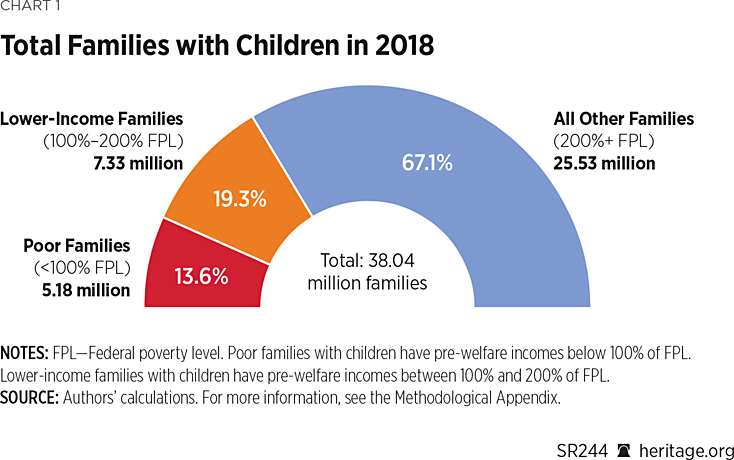
Section 3: Poor and Lower-Income Families with Children
There are 38 million families with children in the United States.REF These families can be divided into three income groups (see Chart 1):
-
Poor families with children. These are families with pre-welfare cash incomes below 100 percent of the official federal poverty level (FPL) before receipt of any means-tested assistance. The government’s official poverty measure cutoff representing 100 percent of FPL in 2018 was $20,231 for a single parent with two children and $25,465 for a married couple with two children.REF The government’s official poverty measure cutoff averaged $26,354 across all poor families with children.REF
There were 5.18 million such families with pre-welfare incomes below these levels. These families included 11.1 million children and 9.2 million adults. The average family size is 3.9 persons with an average of 2.2 children per family. Three-tenths of these families were married couples; a third included an added adult relative of the family head within the family. One in seven included a cohabiting adult partner. This population corresponds very closely to the population defined as poor in the annual Census official poverty reports.REF
-
Lower-income families with children. This group covers families with children and incomes (before receipt of means-tested aid) above 100 percent of FPL but below 200 percent of FPL (twice the FPL for a given-size family). Thus, 200 percent of FPL would be twice the 100 percent of the FPL numbers given above. The threshold of 200 percent of FPL in 2018 was $40,468 for a single parent with two children and $50,903 for a married couple with two children. Thus, the lower-income group would cover families with annual incomes between 100 percent of FPL and 200 percent of FPL (roughly between $26,354 and $52,708 on average).
There were 7.33 million families with children with incomes in this range in 2018. These families included 15.1 million children and 15.4 million adults. The average family size was 4.2 persons with 2.1 children. Half of these families were married couples; half included an added adult relative of the family head within the family. One in seven included a cohabiting adult partner.
-
Other families. This group consists of families with children and incomes (before receipt of means-tested aid) above 200 percent of FPL. There were 25.53 million such families with 44.9 million children in 2018. Overall, nearly two thirds of children live in families with incomes above 200 percent of FPL.
Appendix Tables A-3 and A-4 show the distribution of benefits between these three groups.
Total Economic Resources of Poor Families. In 2018, total government expenditures for poor families with children (net of administrative costs) came to $337.7 billion. (See Appendix Table A-5.) There were 5.12 million poor families; dividing the total expenditures by the number of families yields an average of $65,156 per poor family. Total spending was divided into four categories:
-
$107.6 billion (31.9 percent) for cash, food, and housing;
-
$87.9 billion (26.0 percent) for medical care;
-
$116.5 billion (34.5 percent) for public education; and
-
$25.7 billion (7.6 percent) for direct social services.
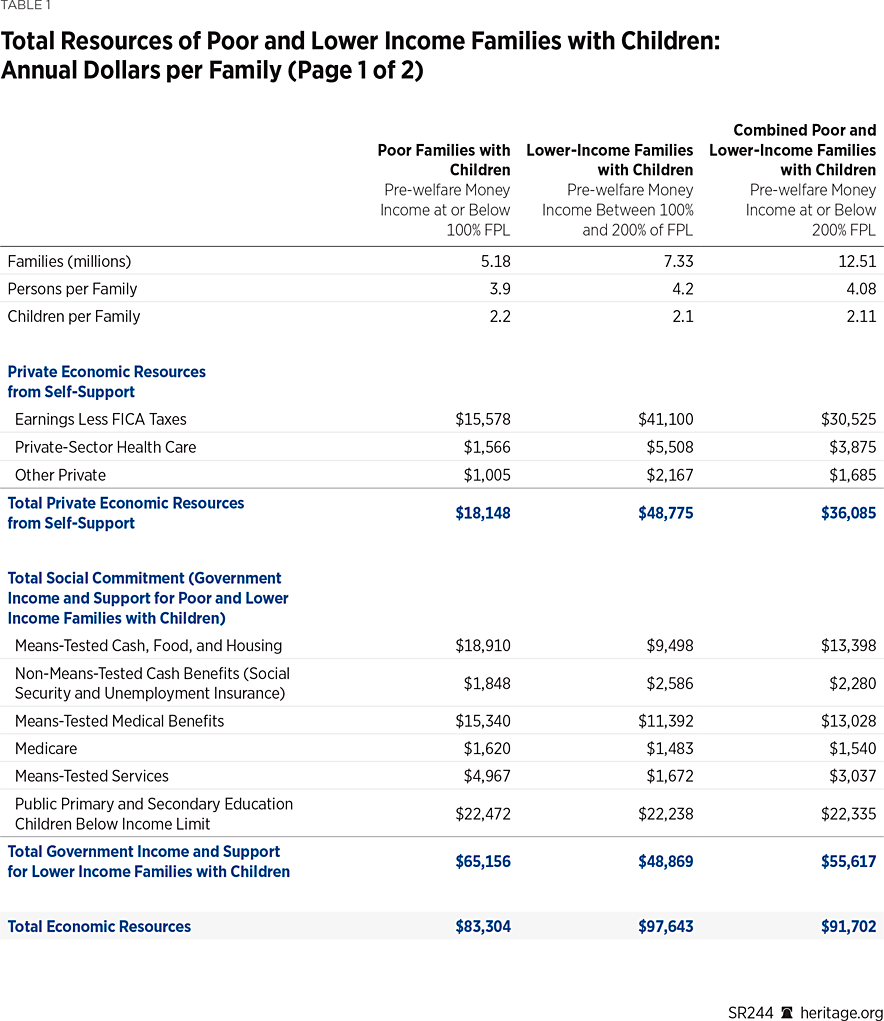
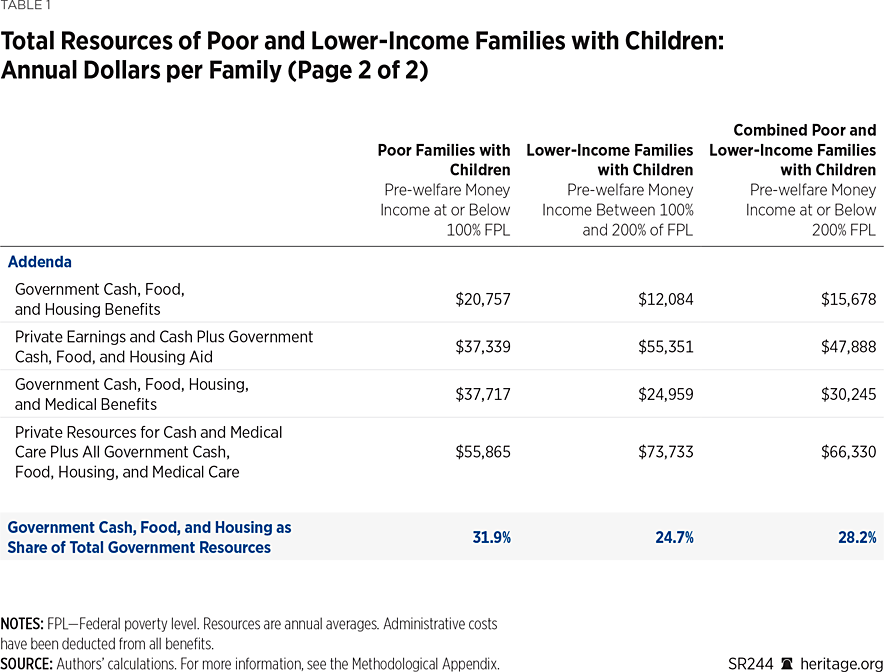
Combined total resources are the sum of government and private resources. In 2018, the combined total resources for poor families with children came to $431.7 billion ($337.7 billion in government resources and $94.1 billion in private resources). The self-support ratio was 22 percent; 78 percent of resources used by the families came from taxpayers, and 22 percent came from self-support. (See Appendix Table A-5.)
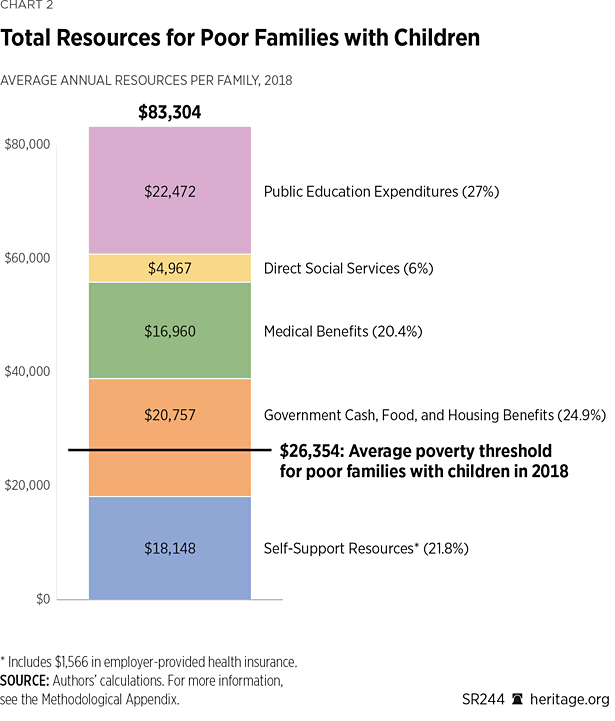
Table 1 and Chart 2 show the average of these resources per family. The combined total resources per family among poor families averaged $83,304 per year.
-
Post-tax earnings and other private resources were worth $18,148;
-
Government cash, food, and housing benefits cost $20,757;
-
Governmental medical benefits added an average of $16,960;
-
Direct social services cost $4,967; and
-
Public education cost $22,472.
Chart 3 shows the components of total resources added together in sequence. First, self-support resources equaled $18,148. Adding $20,757 of government cash, food, and housing benefits brought the total to $38,905. Adding government and employer-provided medical care raised the sum to $55,865. Finally, adding spending on public education and direct social services brought the overall total to $83,304 per family per year.
Note that the cost of self-support resources and government, cash, food, and housing aid came to $38,905. This is nearly 150 percent of the average official poverty measure threshold of $26,354 for poor families with children in 2018. Of course, some individual families would have received resources below that average, while others would be above average. Thus, some families may still face material shortages; however, the magnitude of the average resources received per family makes claims of widespread national hunger, malnutrition, and inadequate housing less plausible. (For additional detail on cash, food, and housing benefits, see Appendix Table A-6.)
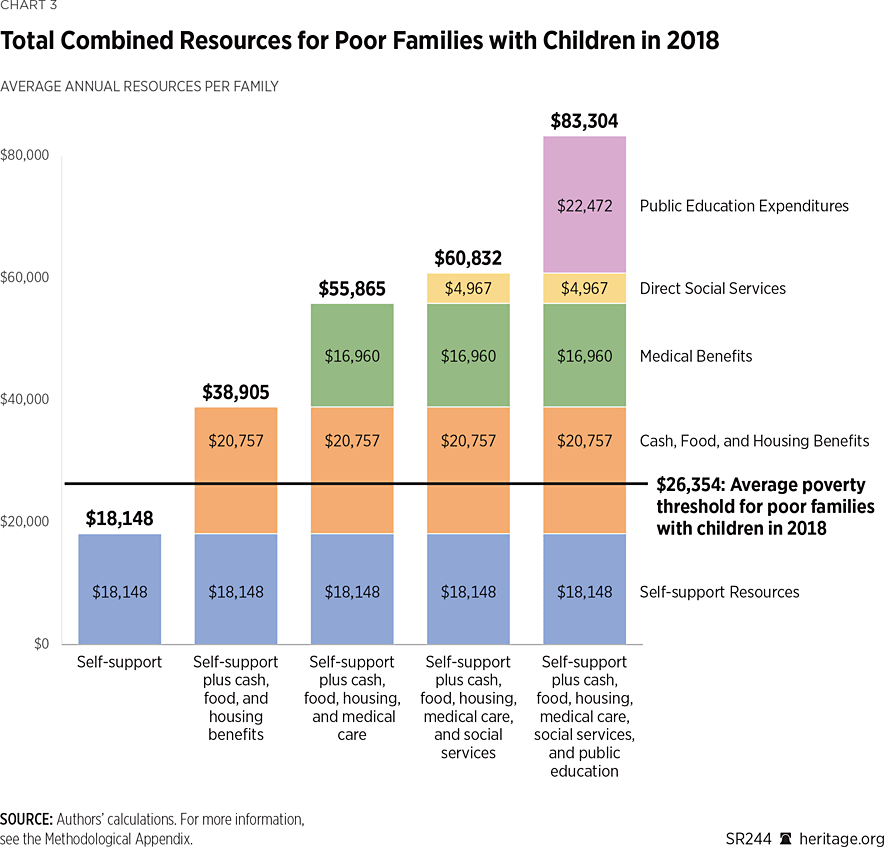
Resources of Lower-Income but Non-Poor Families with Children. In 2018, lower-income families with children had reported pre-welfare cash incomes between 100 percent and 200 percent of FPL. There were 7.33 million such families with an average of 4.1 persons, including 2.1 children, per family. Total economic resources allocated to these families came to $715.3 billion. (See Appendix Table A-5.)
Private and governmental resources are equally split in this group. Private cash income and employer-provided benefits came to $357.3 billion. Total government support from cash, food, housing, medical care, direct services, and education (net of administrative costs) came to $358.0 billion. The average self-support ratio among these families was 50 percent.
Table 1 and Chart 4 show the average per-family resources of these families. The combined total resources per family among the lower-income families averaged $97,643 per year.
-
Post-tax earnings and other private resources were worth $48,775;
-
Government cash, food, and housing benefits cost $12,084;
-
Governmental medical benefits added an average of $12,875;
-
Direct social services cost $1,672; and
-
Public education cost $22,238.
Earnings and other private cash income combined with government cash, food, and housing aid came to $55,351 in 2018.REF This was more than twice the poverty level for a family of four. Adding medical benefits raised the total to $73,733 or roughly three times the poverty level.
The main difference between this group and the poor families and lower-income families involved earnings, other private income, and employer-provided health insurance. Among lower-income families, these came to $48,775 per year compared to $18,148 among the families identified as poor.
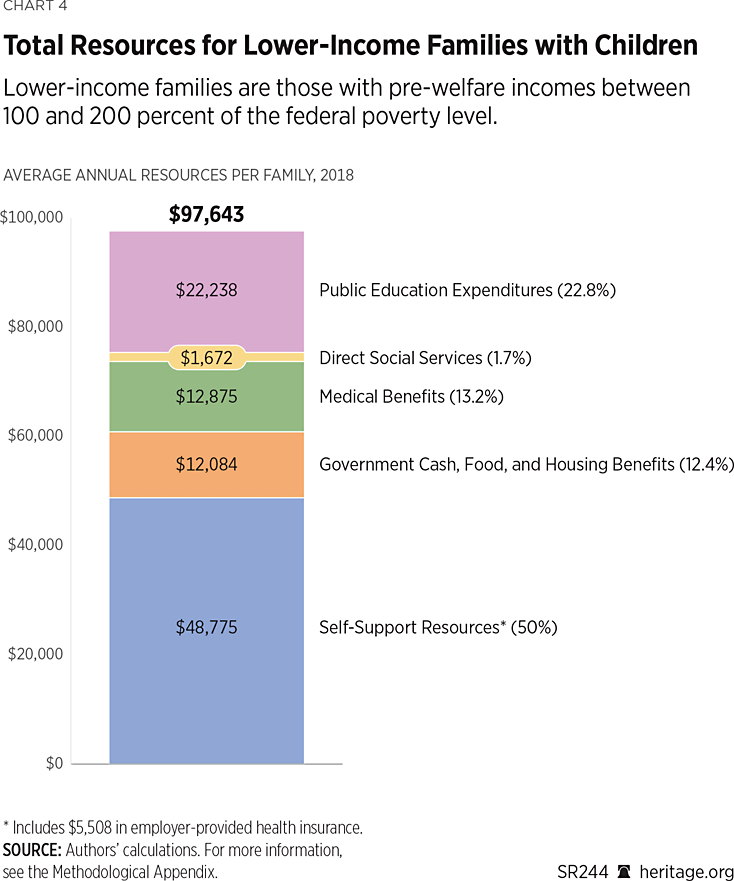
Total Government Support System for Poor and Low-Income Families with Children. The total taxpayer support system for poor and lower-income families with children represents total government spending utilized to meet medical needs, educational needs, and physical needs and wants of those families. In 2018, these two groups combined totaled 12.5 million families and 26.3 million children—roughly a third of all children in the U.S.
The support system spent $695.7 billion providing cash, food, housing, medical care, direct social services, and education to these families in 2018:
-
$196.1 billion (28.2 percent) for cash, food, and housing benefits;
-
$182.2 billion (26.2 percent) for medical care;
-
$38.0 billion (5.4 percent) for direct social services; and
-
$279.3 billion (40.1 percent) for primary and secondary education for the children in these families.
This $695.7 billion was greater than total spending on national defense, which came to $631.2 billion in 2018.REF The upper boundary of the system, limiting the system only to families with incomes below 200 percent of FPL, is somewhat arbitrary. An additional $118.6 billion in means-tested spending went to families with pre-welfare incomes above 200 percent of FPL (mainly those with pre-welfare incomes between 200 percent and 300 percent FPL, which was approximately $79,000 in 2018).
Section 4: Shortfall of Resources in Census Poverty Reports
A fair question would be how, exactly, the government comes to define a family with nearly $83,300 in annual economic resources as poor. A large part of the answer is bad data. Nearly all public discussions about poverty, incomes, and inequality in the U.S. are based on figures published in the Census Bureau’s official poverty report, Income and Poverty in the United States, which is issued annually.REF
Census defines a family as “poor” if its measured income falls below the federal poverty level. However, Census measures income through an odd concept called “money income.” Reasonably, money income does not include spending on social services and education, but by definition, it does explicitly exclude nearly all means-tested cash, food, and housing programs as well as all government medical benefits and employer-provided health coverage.
Most major means-tested welfare programs are deliberately and entirely excluded in the Census poverty report. The omitted programs include cash grants from the EITC; cash grants from the ACTC; and all food stamp benefits, WIC benefits, child nutrition aid, Section 8 housing vouchers, public housing aid, energy assistance, Medicaid, and CHIP. In the two means-tested cash aid programs that are included (SSI and TANF), benefits are consistently underreported.
When it comes to defining and measuring poverty, incomes, and inequality, the government’s official poverty report treats nearly the entire means-tested welfare system as nonexistent and off the books. In 2018, out of a total of $527.5 billion spent on means-tested benefits for families with children, Census counted only $14.1 billion (2.5 percent) as income for purposes of its official poverty measurement.REF Despite the taxpayers’ massive financial commitment to supporting the poor, nearly all taxpayer-funded benefits are specifically ignored when the government measures poverty.REF (See Appendix Table A-7.)
Earned income is also undercounted in the government poverty report. On a family-by-family basis, comparison of the actual earned income reported on IRS and Social Security tax records with the figures for the same family in the Census income survey shows that both low-income and high-income families consistently and substantially underreport income.REF On average, a third of all earnings among low-income filers is missing in the Census poverty data.REF These figures apply to all lower-income tax filers, not just families with children, but it seems reasonable to assume that a similar undercount occurs within the latter group.
Census Poverty Data and Poor Families with Children. Chart 5 compares government money income resources received by the average poor family with children in 2018 according to the official Census poverty report with actual resources received or spent on behalf of those families. According to Census, the resources provided from means-tested government programs came to $1,590 for each poor family.REF Non-means-tested cash benefits counted by Census added another $1,535, and total government resources averaged $3,125.
In reality, government cash, food, and housing benefits alone for these families averaged $20,757. Census failed to count 85 percent of these benefits. Total government benefits per poor family from all sources came to $65,156. Census missed 95 percent of these benefits.
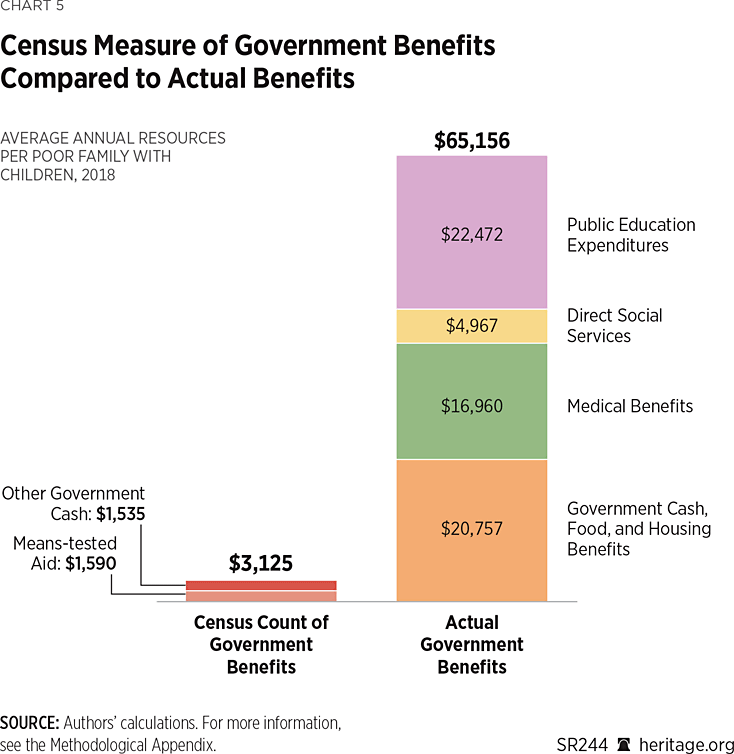
Census does a better job reporting earnings than it does reporting government benefits, but the undercount is still significant. In 2018:
-
When Census combined earnings with all government cash benefits, it reported that the average poor family with children had only $15,662 in combined income. In reality, self-support resources combined with government cash, food, and housing benefits averaged $38,905 for these families.REF Census missed two-thirds of the cash, food, and housing benefits available to those families.
-
Adding medical care brought the average resources of poor families with children to $55,865. Census missed 71 percent of those resources.
-
Finally, adding public education support and direct social services brought the combined total resources of the average poor family with children to $83,304.
Reporting only $15,662, Census missed 80 percent of actual resources available to each poor family. By any measure, Census dramatically undercounts the economic resources of poor families.
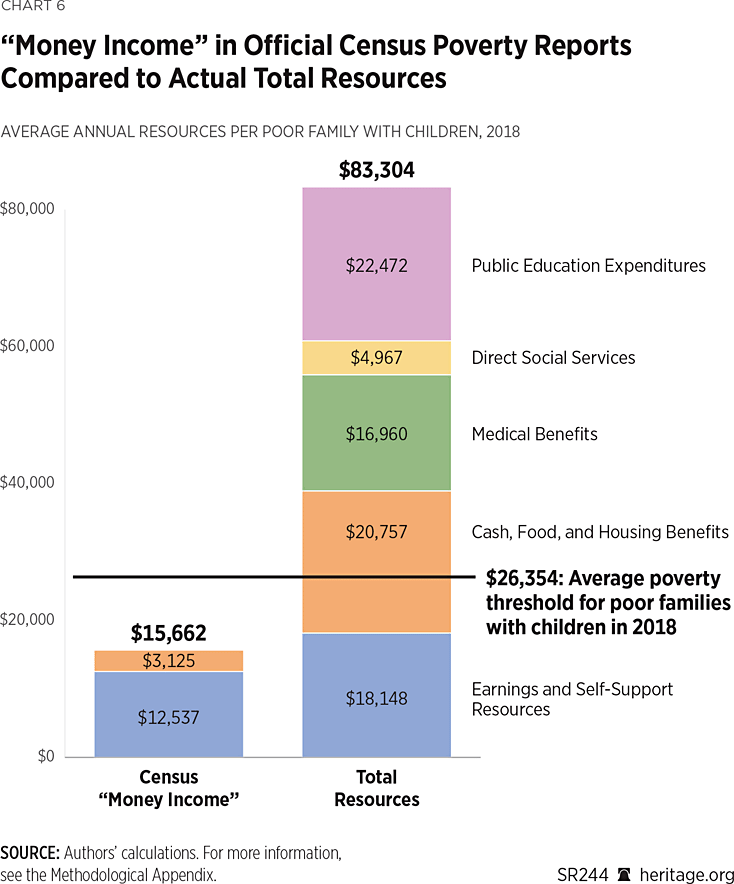
Section 5: Measuring Total Resources and Poverty
Accurate data on the complete government support system and combined total resources for poor and lower-income families with children provides vital information to policymakers. However, these measures are not directly appropriate to the assessment of physical poverty.
Physical poverty relates to the purchasing of food, housing, clothing, and other physical necessities, but among poor families, 54 percent of total resources is dedicated to medical care, education, and services. While this funding can be critical, it obviously cannot be used to meet such physical needs as food, shelter, and clothing. A hungry child cannot eat a math lesson or an appendectomy.REF
However, measures of the total government support system and combined total resources provide an indispensable context and vital complement to any correct measure of physical poverty. Sound policymaking requires both a holistic account of spending on the total support system and an honest and accurate count of spending on cash, food, and housing benefits to meet physical needs.
Although conventional measures of poverty monopolize public discussion, the count of total resources better reflects the real policy priorities of the public and most policymakers. Actual public policy places a very high emphasis on providing free primary and secondary education and free medical coverage to low-income families with children; it places much less emphasis on guaranteeing cash and cash-like transfers. Focusing exclusively on cash, food, and housing aid while excluding free education and medical care dramatically understates and distorts the actual taxpayer commitment to the poor.
Accurate information on the total support system highlights the balance of obligations between taxpayers and recipients. Conventional poverty measures exclude nearly all taxpayer support and therefore give a distorted image of this balance, as 78 percent of the resources utilized by poor families come from the taxpayer.
There has been a broad consensus that education and medical care should be provided to lower-income families with children without any substantial work obligation on the part of parents. By contrast, all major cash programs for these families have been based on the principle that able-bodied parents have a clear obligation to contribute at least partially to the financial support of the family. Thus, these programs all have work requirements that oblige the parents to work or at least prepare for work as a condition of receiving benefits.
The current welfare system intends that work and welfare should serve as partners. Although in the current system, cash and food benefits alone without work will not raise a family out of poverty, work and welfare together can be very effective in reducing or eliminating poverty. In most cases, if a family has at least one full-time worker, even at minimum wage, the combination of earnings and food and cash benefits from programs such as the EITC, the ACTC, food stamps, and child nutrition will be more than sufficient to raise the family out of poverty.REF The fact that the poverty report understates earnings and ignores these benefits entirely hides the anti-poverty effectiveness of the existing system when combined with work.
However, the system of mutual obligation in effect since the Clinton-era welfare reforms has recently been challenged. The Biden Administration and congressional Democrats are now forcefully seeking to greatly expand cash grants in the Child Credit program while eliminating existing work obligations from the program.
Measuring Physical Poverty Accurately. Finally, the figures presented in this paper provide a basis for an improved measure of physical poverty by linking the value of benefits received by families to actual government outlays as recorded in official budget documents. By contrast, as noted, the official poverty measure undercounts earnings and ignores nearly all means-tested cash, food, and housing benefits provided by the government. When earnings, cash, food, and housing benefits are counted correctly, the total resources from those sources rises to an annual average of $37,339 per family for all families with children defined as poor by the government.REF This is well above the official poverty level of $26,354 for these families.
However, measuring physical poverty with true accuracy will require a new data system. Such a system, called the Comprehensive Income Dataset (CID), has been developed by a team of researchers led by Bruce Meyer of the University of Chicago.REF In the CID, families responding to Census demographic surveys are linked at the individual family level to administrative records of benefits provided at the Department of Health and Human Services, the Department of Housing and Urban Development, and other departments. Accurate information about earnings is obtained from tax records at the Social Security Administration and the Internal Revenue Service.
This system will provide, for the first time in the U.S., accurate and detailed information about the earnings and benefits among low-income Americans at the individual family level. Preliminary information suggests that this accurate information may cut the overall measured poverty rate by at least 60 percent.REF
Section 6: The Build Back Better Act’s Unprecedented Expansions of Means-Tested Benefits
The taxpayer currently provides an average of $65,156 in support to poor families with children, but to the Biden Administration and the current Congress, that is not nearly enough. In March, President Biden proposed the American Families Plan with enormous increases in means-tested spending. Most of the elements of this plan were incorporated into the original Build Back Better legislation in the House of Representatives.REF In late October and early November , the majority party in the House introduced revised versions of this bill.REF
The original Build Back Better bill had an alleged price tag of $3.5 trillion over 10 years. The revised version of the bill has an alleged price tag of $1.75 trillion over 10 years. However, most of the “savings” in the revised bill occur because its new spending initiatives are terminated or dramatically scaled back after six years or less. This is a routine budgeting gimmick to conceal long-term costs.REF The Penn Wharton Budget model estimates that the true 10-year cost of the policies included in the $1.75 trillion package is $4.1 trillion.REF
As the press has widely reported, because the originators of these new programs presumably do not really want their projects to end, terminating funding after a few years is primarily a tactic to reduce the apparent costs of the new programs within the 10-year budget window.REF They believe that the programs will be popular and that Congress will be unwilling to let them lapse within a few years. For example, the Administration claims that the child care and pre-kindergarten provisions of the bill will cost $400 billion over 10 years, but spending in both programs is increased incrementally and then terminated after the sixth year (2027). This truncation greatly reduces the apparent cost of the programs.
Moreover, from 2025 through 2027, spending in the two programs is open entitlement with no ceiling. The government will spend “such sums as may be necessary” to achieve the universal policy goals. Actual expenditures in the programs are likely to be far greater than the non-binding sums floated by the Administration.
If the child care and pre-kindergarten programs were extended through the full 10-year budget (through 2031), the cost would be not $400 billion but at least $854 billion. And given the uncapped entitlement nature of the funding, the actual number could be far higher.
Total Means-Tested Spending. If enacted, the revised bill would generate an additional $167 billion in means-tested spending in its initial year of operation.REF In addition, the Biden Administration has already expanded food stamp benefits by 21 percent through administrative action for an added cost of $16 billion per year. The combined cost would come to at least $183 billion per year. Total means-tested spending in the initial year of the plan’s operation would be by far the greatest increase in means-tested welfare spending in U.S. history. The five-year cost of the new spending would be around $836 billion.
If the all of the means-tested spending initiatives in the bill and the food stamp expansion were fully funded to the end of the 10-year budget window, the cost would be more than $2.5 trillion. The means-tested costs alone would exceed the bill’s alleged total price tag of $1.75 billion.
New Funding for Families with Children. Under the bill, new means-tested spending for families with children would equal $129 billion in the initial year after enactment. Adding the cost of the administrative food stamp increase for families with children would bring the annual sum of new spending to $139 billion. Among the major new spending items are:
-
Unconditional cash grants through the new Child Allowance. This policy would dramatically alter the existing child credit program. Benefits would be raised from $2,000 per child to $3,000 per child ages six through 17 and $3,600 for younger children in 2022 before returning to their current-law level of $2,000 per child in 2023. Critically, the policy eliminates the existing work requirements, which ensure that families must work to support themselves to be eligible for benefits. Whereas nearly all of the existing child credit goes as income tax relief to working families with children, under the new policy, 76 percent of added benefits in the first year and 100 percent in subsequent years would be cash grants to families that owe no income tax.REF The cost of the cash grants would be $78 billion in the first year and $27 billion in subsequent years; most would go to families that worked very little or not at all during the year. In 2023 and subsequent years, the majority of children in single-parent households but only one-fifth of children in married-parent households would receive increased benefits under the bill, further disincentivizing marriage among low-income to middle-income households.
-
Low-income housing. The bill contains more than 16 separate provisions to increase spending on low-income subsidized housing. Most of the program expenditures terminate after five years. The five-year cost would be around $131 billion, or $26.2 billion per year per year net of administrative costs. This represents a nearly a 50 percent increase in baseline housing spending of $55.3 billion per year. Given historic spending patterns, approximately $12.1 billion of this spending will go to families with children (nearly all non-married single parents).REF
-
Food aid. The bill expands the summer food program for low-income children at a cost of $2.3 billion per year. Moreover, the Biden Administration has recently increased the permanent value of food stamp benefits by 21 percent through an administrative action of dubious legality. The cost of the increase will be at least $16 billion per year, $9.7 billion of which will go to families with children.
-
Medical care. The bill effectively closes the Medicaid coverage gap for adults in the non-expansion states.REF These adults have incomes below the poverty line; they are in a coverage gap because their income is too low to qualify for subsidized health insurance coverage under the Affordable Care Act but too high to be eligible for Medicaid under current state rules. There are some 2.2 million adults in the coverage gap in the 12 non-expansion states; 660,000 of these adults are parents with children in the home. The bill would make these parents eligible for ACA subsidies and provide full funding for the benefits at a cost of around $3.7 billion per year.REF
-
Child care subsidies. The bill proposes a new Birth Through Five: Child Care and Early Learning Entitlement Program. This will subsidize day care in large expensive, secular day care centers. The program would initially target eligibility on families with less than 85 percent of the state median income. Program costs are capped at $24 billion during the first year, rising to $42 billion by the third year. During the fourth through sixth years, the program would be an uncapped entitlement for all children with no mechanism to constrain costs. The Administration estimates that the cost during this period will be roughly $65 billion per year. The real cost would certainly be far higher. A progressive sliding fee structure allows those with the lowest incomes to have the costs of the most expensive day care fully subsidized.REF It also strongly discourages marriage among dual-earner couples, because only one parent’s income will be counted if a couple remains unmarried, but both will be counted if the couple marries.REF
-
Free universal pre-kindergarten for all three-year-olds and four-year-olds. The initial costs of this proposal will be $7.3 billion in the first year, rising to $15.3 billion by the third year, followed by the federal government paying a declining share of states’ total costs. Initial funds will be targeted at high-poverty communities.REF This policy features uncapped and uncontrolled spending stream that will almost certainly greatly exceed the reported total of $23 billion per year in the second three years.REF
Increased Benefits per Poor Family
As noted, the bill combined with the administrative increase in food stamps would provide an additional $139 billion in benefits to families with children in 2022. Of this amount, some $58 billion would go to poor families. The new spending per poor family would be:
-
$5,738 per family in cash grants from the new child allowance;
-
$1,211 from an increase in food stamps;
-
$390 for the summer food program;
-
$2,061 in new low income housing subsidies;REF
-
$711 in added medical care;
-
$841 in child care subsidies;
-
$485 in pre-kindergarten education subsidies; and
-
$36 in new social services.REF
The average poor family would receive $9,262 in new cash, food, and housing aid; $711 in added medical care; and $1,317 in child care, pre-kindergarten education, and direct social services. On average, families would receive $11,290 in new government resources under the revised Build Back Better proposal plus the administrative increase in food stamps. These are average amounts for all poor families with children. Some families would receive significantly more, for example, if they had housing subsidies or if they are using government child care or pre-kindergarten benefits. Other families would receive less.
Table 2 shows the impact of adding the $11,290 in new benefits to the $65,156 the average poor family currently receives in government resources. Total government resources for the average poor family with children rise from $65,156 to $76,444. (See Chart 7.)
The act would add $9,262 per family in cash, food, and housing benefits to the $20,757 in such benefits currently received per family. Added together, the current and new benefits would bring the total governmental cash, food, housing benefits to $30,018. Thus, the average government cash, food, and housing benefits alone would be greater than the average poverty thresholds among poor families without counting any earnings or medical care.
Current cash, food, and housing benefits combined with earnings and other private cash income come to $37,339. Adding new cash, food, and housing benefits of $9,262 would bring the total to $46,600—177 percent of the average official poverty threshold within the group.
Finally the combined resources from total government support and earnings and other private resources currently come to $83,304 per year. Adding the new $11,290 to the existing total would bring the total resources available to the average family, defined as poor, to $94,539. (See Chart 8.) Even if public education, child care, and services are excluded, the figure comes to $65,837 per year.
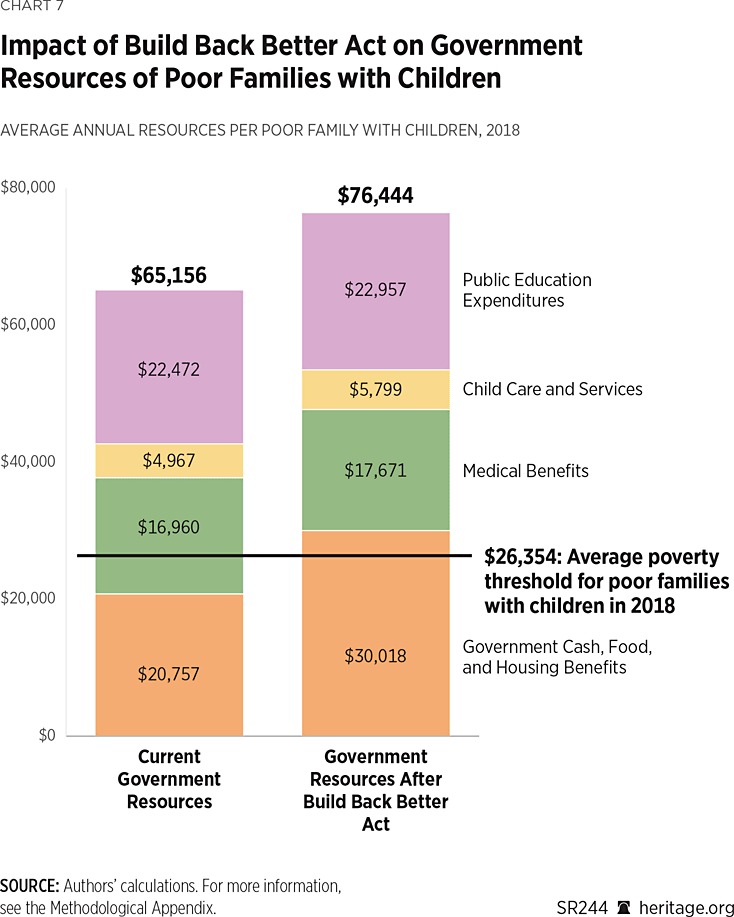
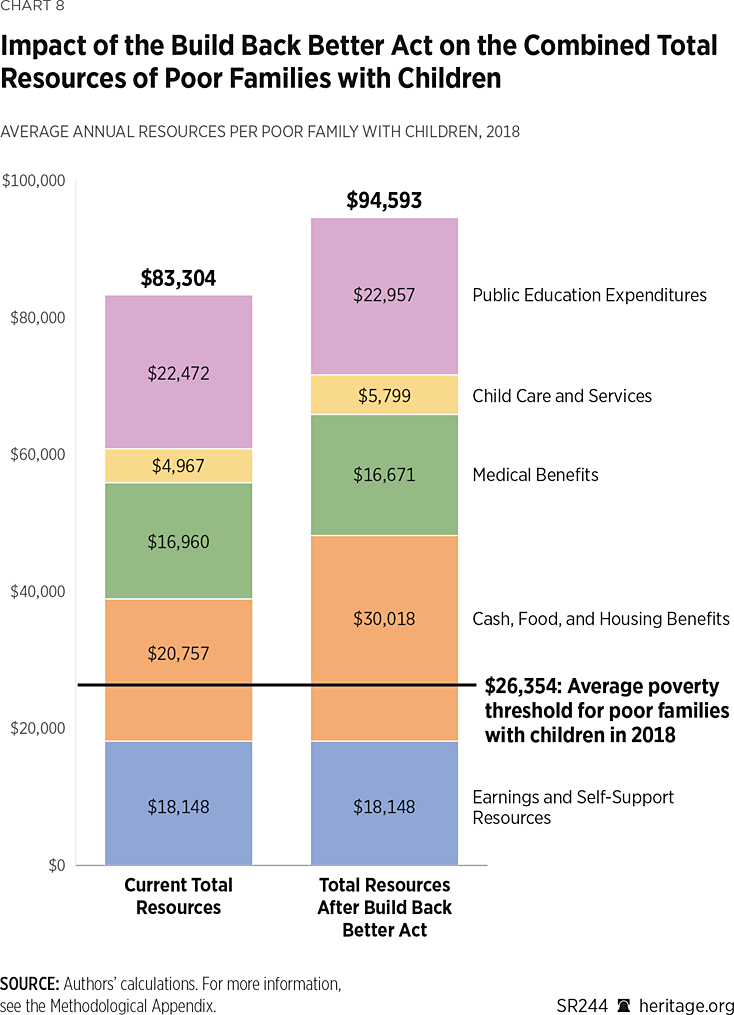
The remarkable irony of this planned tidal wave of spending on the poor is that when the standard Census report on Income and Poverty in the United States is issued in future years, none of the new spending will be counted as money income.REF Therefore, the new benefits will have no countable effect on the poverty rate as measured by the official poverty measure. The poverty rate will remain at exactly the same level as it would be if the spending had never occurred: All of the added spending will simply disappear behind a statistical smoke screen.
This has been the fate of virtually every expansion pf the welfare state since the mid-1960s.REF Since the beginning of the War on Poverty, the United States has spent $34 trillion on means-tested welfare, but Census has counted only $2.6 trillion for purposes of measuring poverty and income. From the perspective of the Census, the missing $31.4 trillion is simply off the books.
As far as government poverty statistics go, the War on Poverty never actually happened. It is not likely to be any different this time.
Conclusion
The government support system for poor and lower-income families consists of government spending to meet the medical, educational, and physical needs and wants of those families. In 2018, this system cost $695.7 billion.
The combined total resources of these families equal the cost of benefits and services provided by the government support system plus earnings and other private income obtained by the family. In 2018, the total resources of the average “poor” family as defined by the government came to $83,304 per year.
The Biden Administration is proposing the largest expansion of means-tested spending in U.S. history.
-
Means-tested spending on families with children would jump immediately by $139 billion per year;
-
Government benefits and services for the average poor family would be increased from $65,156 to $76,444 per year; and
-
Combined resources from government support and private earnings and self-support would reach $94,593 per year for the average poor family.
Even if spending on social services and public education were omitted, the remaining resources would still equal $65,837.REF Moreover, work requirements would be removed from the largest means-tested cash program, and penalties against marriage would be increased.
Good public policy must be based on good information. Regrettably, the information provided on the social safety net and the poor is consistently fragmentary, incomplete, and inaccurate. For example, out of the $695.7 billion that taxpayers spent in 2018 on benefits and services for poor and lower-income families with children, only 4.9 percent appeared in the official Census report on poverty.REF Both earnings and government aid are significantly underreported.
It is irresponsible to call for massive increases in welfare spending without accurate and accessible information on what is currently being spent and what benefits are received. Unfortunately, government does not produce this basic information in an accurate and accessible form. To correct this situation, the federal government should annually report figures on total means-tested spending by federal and state governments. It should also report spending on the total support system for poor and low-income families with children.
Policymakers must also recognize that the information government provides on the incomes and benefits of families and individuals through surveys such as the Census Bureau’s Current Population Survey and American Community Survey is consistently incomplete and inaccurate. These data cannot be used in their current form for public policy analysis. They should be replaced by a modern system that provides more accurate information by linking demographic data to actual administrative records of benefits and income received. Overall, this accurate information would provide a sound foundation for reasonable public policy debate.
At present, the massive spending hikes proposed in the Build Back Better Act are unnecessary and harmful. They represent lucrative payoffs to special-interest groups including the public-school industry and large center-based day care.REF The day care and pre-kindergarten expenditures will not benefit poor children and are likely to be harmful to both middle-class and working-class children.REF
In addition, the unprecedented increases in cash, food, and housing benefits will significantly increase the welfare system’s already potent penalties against marriage.REF They will reward families for not working. In the long term, they will harm both the poor and society.
Robert Rector is Senior Research Fellow in Domestic Policy Studies, of the Institute for Family, Community, and Opportunity, at The Heritage Foundation. Jamie Bryan Hall is a Research Fellow in Quantitative Analysis in Domestic Policy Studies.
Methodological Appendix
Introduction
The income and other economic resources received by poor and lower-income persons are a vital public policy concern. Regrettably, information on this subject is almost completely lacking. While partial information is sometimes available, it is never integrated into a comprehensive picture of resources and the poor. This report is a first-time attempt to provide an integrated holistic picture of total resources available or spent on behalf of poor and lower-income families.
The accurate measurement of the total resources available to poor and lower-income families with children involves six issues:
-
The accurate and comprehensive count of expenditures in the means-tested welfare/transfer system;
-
The determination of who actually receives the funds dispensed by the means-tested system;
-
The linking of total benefits reported and imputed to actual total outlays in programs according to budget sources;
-
The determination of the actual earnings of the poor, a resource that is consistently undercounted in government surveys;
-
The inclusion of non-means-tested benefits that at times are received by poor families; and
-
The measurement of public education spending for poor and lower-income children that occurs outside the means-tested system.
The methods used in this report resolve each of these issues.
Four Systems to Measure Income, Benefits, and Poverty
Currently, four systems are available to measure the economic resources obtained by the poor.
Official Poverty Measure (OPM). Government efforts to measure income and the receipt of welfare benefits began with the first Census Current Population Survey publication covering the year 1945.REF Census has continued this same basic survey for the past 75 years. The income data are currently collected in the March Annual Social and Economic Supplement of the Current Population Survey (CPS/ASEC).
In its first survey, Census measured the “money income” of families and individuals. Money income included cash welfare benefits from Aid to Families with Dependent Children (AFDC) and General Assistance (GA).REF This limited focus on money income continues today.
At the onset of the War on Poverty in 1965, Census issued its first report devoted specifically to poverty.REF This report became the basis of the official poverty measure, which has been issued yearly ever since then. As in prior Census income reports, the first poverty report was based on money income, which included only AFDC and GA benefits. Because these constituted the bulk of welfare aid at the time, this approach was not initially problematic.
However, in the late 1960s through the 1970s, the federal government added an array of new transfer programs: Medicaid, food stamps, WIC, and cash grants through the EITC. The school lunch and subsidized housing programs were greatly expanded. By 1980, inflation-adjusted welfare spending had tripled relative to the beginning of the War on Poverty, reaching $391.9 billion in constant 2019 dollars.
Almost all of the increase occurred in new programs that Census regarded as “non-cash aid,” which it excluded from money income and thereby ignored for purposes of poverty measurement. For 75 years, Census has clung doggedly to its 1945 concept of money income, continuing to count only a portion of AFDC, GA, and SSI for purposes of measuring poverty. By 1980, these three programs constituted only 15 percent of aid to the poor.
Census did quietly introduce questions about receipt of food stamps, housing aid, and Medicaid into its annual Current Population Survey questionnaires, but the data collected from these questions were not published and were not included in the annual official poverty measure. Census has continued to issue its widely publicized official poverty report unchanged for nearly half a century despite the shifting policy landscape.REF
Supplemental Poverty Measure (SPM). In 2013, the Obama Administration introduced the Supplemental Poverty Measure.REF The SPM became an annual report running parallel to the OPM reports, although the latter continued to draw nearly all of the press attention.
The SPM is based on data from the CPS/ASEC survey but includes some information on non-cash benefits that are not included in the standard OPM report. The SPM omits all medical benefits and undercounts earnings in low-income households exactly as the OPM does. Although the SPM does report receipt of the EITC and ACTC and some food and housing benefits, these benefits are substantially undercounted overall. Comparison of budgetary spending totals (less administrative costs) shows that 39 percent of means-tested cash, food, and housing benefits is still missing in the SPM. In 2018, for example, some $81 billion in means-tested cash, food, and housing aid received by families with children was missing from the SPM.
Despite the inclusion of a greater share of means-tested aid in the SPM, the poverty rate is actually higher in the SPM than it is in the OPM. This is because the SPM uses a complicated system that substantially raises the effective SPM poverty income thresholds relative to the OPM thresholds. In effect, the effective poverty thresholds or cutoffs for poor and lower-income families with children are about 31 percent higher in the SPM than they are in the OPM. This increase in the thresholds offsets the greater inclusion of means-tested benefits in the SPM.REF More strikingly, future poverty thresholds are linked to the rise in the general income so that the thresholds will increase faster than inflation. This system measures inequality rather than poverty in any normal sense.
CBO Measure of Resources. New methods for measuring income and resources have been developed by other branches of government. The Congressional Budget Office (CBO) is responsible for analyzing the distribution of income across quintiles and applying that framework to the analysis of legislation. It has recognized that the measures of benefits in the Census OPM and SPM were seriously incomplete, skewing the distribution of income figures. Unadjusted Census data in the OPM and SPM were misleading for policy analysis. CBO noted two reasons why better data were needed:
First, because means-tested transfers are a key source of income for lower-income households, uncorrected [Census] survey data will tend to understate income at the bottom of the distribution and the role of means-tested transfers in reducing income inequality. Second, because underreporting of transfers has increased, uncorrected survey data will tend to underestimate the growth in incomes at the bottom of the distribution.REF
CBO added that “[b]ecause the Census Bureau’s corrections are not designed to match administrative totals [for either recipients or outlays], they do not solve the underreporting problem in the CPS.”REF
In response, CBO has developed a process to correct the underreporting in the CPS/ASEC. It first collects data from administrative records on the total outlays in the program (less administrative costs) and the number of recipients of benefits in various demographic categories. These become the “administrative targets” for its system.REF It then imputes additional benefits and recipients into the CPS data until the adjusted CPS data correctly reflect the actual number and characteristics of recipients and the dollar value of benefits as they exist in the real world. CBO produces corrected estimates for four programs: Medicaid, CHIP, SSI, and food stamps.
Linking to Administrative Data. In January 2021, an Interagency Technical Working Group (ITWG) in the executive branch recommended a new method of data collection to overcome the substantial and growing problem of underreporting of income and resources that had plagued the Census Current Population Survey since 1945.REF This new method, among other things, would involve linking Census survey data to government administrative records of benefits and earnings at the individual case level.REF
For decades, it has been known that when respondents in a survey are asked to report income and benefits, they generally underreport these resources. Underreporting is most severe at the lowest and highest levels of the income spectrum. The best way to correct this underreporting is to link the demographic data for a given family that are provided in government respondent surveys with the data on benefits received by that same family that are available in actual administrative records for programs such as food stamps and housing. Information on earnings and the EITC can be cross-checked with records at the Social Security Administration and the Internal Revenue Service. This approach has been advanced by the Comprehensive Integrated Dataset (CID) project led by Bruce Meyer at the University of Chicago.REF
If fully implemented, a system of administrative linking would provide accurate information on the income and benefits actually received by individual families and individuals, particularly among lower-income families, for the first time in U.S. history. Although this sort of accurate information would seem to be a prerequisite for rational policymaking regarding poor and lower-income families, the government has never previously bothered to collect it.
Estimation Methods Used in This Report
This report does not attempt to estimate benefits received by particular families. Rather, like the CBO analysis, it seeks to estimate the aggregate benefits received by broad groups. CBO estimates the share of benefits going to income quintiles; this report calculates the share of program benefits received by three groups: poor families, lower-income families, and other families. The estimating procedure used is similar to but simpler than the CBO method and achieves results quite similar to CBO’s. The use of a simpler procedure is attractive because of the increased number of estimated programs.
The current procedures start with an administrative target for each program that is equal to the total outlays for the program according to budgetary sources less administrative expenditures. In most cases, the proportionate allocation of benefits in the program reported in the CPS/ASEC data for each of the three groups is used to estimate the share of total outlays in the program. The share of reported benefits for each group in the CPS/ASEC is assumed to equal the share of total outlays for each group. For example, if the CPS/ASEC data show that for program X, poor families receive 42 percent of benefits, lower-income families receive 34 percent, and other higher-income families receive 24 percent, the share of total outlays (reported and unreported) is assumed to be the same.
The assumption here is that while CPS/ASEC underreports benefits, the rate of underreporting is uniform across income groups. If, in reality, poor families are more likely to underreport, the procedure will underestimate the actual benefits they receive.
The estimation procedures used in this report run parallel to the results obtained with the more complex methods used by CBO. This can be verified with the useful comparisons CBO provides for its data and the unadjusted CPS/ASEC data. These comparisons show that while the absolute CBO numbers are greater because they impute the missing benefits, the distribution of recipients by income class is symmetric between the two systems.REF This should be expected because CBO uses the unadjusted CPS/ASEC data to predict the allocation of the missing data. Since the benefit estimates in this report are also symmetric with the unadjusted CPS/ASEC distributions, it follows that they should be quite similar to CBO calculations, at least for the programs CBO has analyzed.
It is possible that both systems underreport benefits going to the poor. Some studies using linked administrative data show that underreporting of benefits is more pronounced among lower-income recipients than it is among higher-income recipients. In an analysis of administrative data from the states of Illinois and Maryland, Bruce Meyer et al. find that “[f]ood stamp receipt declines more rapidly with income in the administrative data, so analyses using survey data only are likely to understate the distributional consequences of the Food Stamp Program.”REF In other words, a greater share of actual food stamp benefits goes to poorer families than is shown in the CPS survey. This result holds not only for the CPS, but also for other Census surveys, including the American Community Survey (ACS) and the Survey of Income and Program Participation (SIPP).REF It is also consistent with an earlier study of food stamp underreporting in SIPP that used administrative data from Florida, Pennsylvania, and Wisconsin.REF
Estimates Far Superior to OPM and SPM Figures
The estimate of the resources currently received by poor families with children uses the assumption that underreporting of resources in the CPS/ASEC is uniform across family income groups. In light of the studies comparing administrative and survey data, this assumption seems conservative, but that cannot be proven at this time. Moreover, the errors introduced by the assumption will certainly be much smaller than the manifest errors produced in the OPM and SPM.
For example, in the CPS/ASEC database, poor families receive 42 percent of all reported means-tested cash, food, and housing benefits going to families with children. The model used in this report assumes that these families also receive 42 percent of the undercounted cash, food, and housing benefits that are missing in the CPS/ASEC. On average, the poor families have $10,532 in reported benefits and another estimated $8,378 in missing or underreported benefits. Together, these families receive an average of $18,910 per year in total cash, food, and housing benefits (including both reported and unreported benefits).
The assumption that these families receive 41 percent of the missing cash, food, and housing benefits is not exact. However, the imprecision generated by the assumption will be modest. For example, if one assumes that the 42 percent figure for unreported benefits is either 20 percent too high or 20 percent too low, the poor families would have received between 50 percent and 34 percent of the missing benefits. If the families received 50 percent of the missing benefits, their combined benefits would have been $1,676 higher or $20,686 (compared to $18,910). If they received only 34 percent of the missing benefits, the benefits would have been $1,676 lower at $17,234.
These are modest potential errors, especially in comparison to the vast, self-evident errors that clearly exist in OPM and SPM figures. Yet the OPM and (to a lesser extent) SPM figures are widely cited in the press and literature. According to the OPM method, the poor family receives only $1,590 in means-tested aid. The SPM at least attempts to count cash, food, and housing aid, but it provides no adjustment for the self-evident underreporting of benefits. According to the SPM, the poor family receives an average of $10,532 in means-tested cash, food, and housing benefits; this figure is most likely around $8,000 too low.
Specific Allocation Methods Used in This Report
The first step in the analysis performed in this paper was to determine total outlays for nearly 90 means-tested programs from budgetary sources. The government does not currently provide any comprehensive report on federal and state means-tested expenditures. This report does provide such a comprehensive list of means-tested programs and expenditures in Tables A-1 and A-2 based on government budget documents. These tables update previous research on this topic.REF The tables show that total means-tested expenditures came to $1.16 trillion in 2018.
The second step was to allocate this spending among four recipient groups: families with children; families without children that include a disabled adult; families without children and disabled adults that include at least one elderly, nondisabled person; and families without children that include neither elderly nor disabled members.REF The sum of spending in a program among the four groups equaled total program outlays according to budget sources. This analysis showed that of the $1.16 trillion in means-tested spending in 2018, $527.5 billion went to families with children. (Information on these steps can be obtained upon request from the authors.)
The third step was to allocate the remaining spending totals for each program among the three groups of families with children: poor families, lower-income families, and other families.REF Administrative costs were deducted from the spending totals for each program. The procedures used in this allocation are shown below.
-
Major Programs. For food stamps, WIC, school lunch and breakfast programs, housing benefits, SSI, TANF cash, Low-Income Energy Assistance Program (LIHEAP), EITC, and ACTC grants, benefits were allocated among the three income groups of families with children according to the distribution of reported benefits for these programs in the CPS/ASEC database for March 2019 (covering 2018).REF
-
Medicaid, CHIP, and ACA Benefits. The distribution of Medicaid, Children’s Health Insurance Program, and Affordable Care Act benefits was allocated according to the distribution of enrollees reported in the CPS/ASEC database for March 2019 (covering 2018). The distribution of benefits and the distribution of enrollees will be very similar in the Medicaid and CHIP programs as these programs provide a flat benefit per family that does not reduce incrementally as incomes rise. The ACA program has a benefit phasedown rate linked to income; this means that the procedure may slightly overcount benefits of higher-income families relative to lower-income families.
-
Foster Care Maintenance Payments. Foster care maintenance payments were allocated according to the distribution of foster children in the March 2019 CPS/ASEC. This procedure was appropriate because foster care payments do not vary according to the income levels of the foster care family. The distribution of foster children by foster parent income in the CPS/ASEC was similar to the distribution reported in the National Survey of Child and Adolescent Well-Being (NSCAW II).REF
-
Head Start. Head Start benefits were allocated among the three income groups according to the Head Start Family and Child Experiences Survey (FACES).REF
-
Child Welfare. The distribution of child welfare services by the income level of families was determined from data in the National Survey of Child and Adolescent Well-Being (NSCAW II).REF
-
TANF Child Care Services. TANF child care services were allocated at the same ratio as TANF cash benefits in the CPS/ASEC database.
-
Child and Adult Care Food Program. The share of benefits allocated to children was determined by USDA documents. The allocation by family income class was assumed to match the allocation of school meals in, the CPS/ASEC.REF
-
The Emergency Food Assistance Program (TEFAP). TEFAP benefits by family type and income level were taken from the U.S. Department of Agriculture (USDA) Statistical Supplement to Household Food Security in the United States in 2018.REF
Other Non-Means-Tested Resources
This paper also estimates the following non-means-tested resources received by poor and lower-income families.
-
Social Security and Unemployment Insurance. The Social Security and Unemployment Insurance benefits received by families with children were estimated by determining the aggregate value of these benefits for families with children at each income class from the March CPS/ASEC database and then adjusting for the general level of underreporting for each program in the CPS/ASEC.
-
Medicare. The cost of Medicare benefits for recipients in families with children in each income class was determined by multiplying the number of Medicare recipients in families with children in each income group by the average value of Medicare benefits per person.
-
Earned Income. Earned income is undercounted for lower-income families in the CPS/ASEC database. The Comprehensive Income Dataset (CID) method developed by Bruce Meyer of the University of Chicago links survey data in the CPS on an individual case basis to the same family unit in administrative records.REF Meyer and his fellow authors have linked earnings reports in the CPS survey with reported earnings for the same family unit in tax records at the Social Security Administration and the Internal Revenue Service.
This linkage has demonstrated significant underreporting of earnings in the CPS for the bottom three deciles of reporting units.REF Within the lowest-income 20 percent of tax filers, CPS reported earnings are 32 percent lower than tax records show.REF These figures apply to all lower-income families and individuals, not just families with children, but it seems reasonable to assume that a similar undercount occurs within the latter group.
Based on this finding, the present analysis assumes that roughly a third of all actual earnings of poor families with children are unreported in the CPS. The CPS earnings figures are adjusted upward by a corresponding amount to account for these missing earnings. The average reported earnings for poor families with children in the CPS came to $10,661. Adjustment for underreporting adds $4,917, bringing average total earnings to $15,578. This figure is reported in Table 1 in the text. (All figures are net of FICA taxes.)
Average reported earnings in the lower-income group are more than twice as high as average reported earnings among poor families. The underreporting rate is lower (around 16 percent). Adjustment for underreported earnings in this group raises average earnings by around $6,800, bringing average earnings per family to $41,100. (All figures are net of FICA taxes.)
-
Public Education. The cost of public education services for children in primary and secondary schools was determined by multiplying the number of school-age children in each family by the average cost of $14,364 per student per year.REF In general, this cost does not vary greatly by family income level; contrary to common perceptions, expenditures per student are higher for poor students than for non-poor students in all but three states.REF
Estimates for the Build Back Better BillREF
This section explains the procedures used in estimating the average, annual new resources that would be contributed per poor family if the initiatives in the revised Build Back Better plan were enacted.REF Specifically, the paper sought to estimate costs in the first year after enactment. The following explains the estimating procedures for specific initiatives (all figures are net of administrative costs).
-
Child Allowance. The bill replaces the existing Child Tax Credit and Additional Child Tax Credit, under which a maximum benefit of up to $2,000 per dependent child may be available to a tax filer with sufficient earnings or income, with a child allowance under which the maximum benefit of $3,000 or $3,600 for each child in 2022 and $2,000 in subsequent years is payable with no minimum earnings or income requirement and then begins to phase out at a lower income level. The impact of this proposal was calculated by using the new program parameters to calculate the child allowance in the CPS/ASEC database and subtracting the value of the existing credits. Only child allowance cash grants are counted as resources in this paper. Any income tax relief that is generated by the new policy is not counted in the aggregate or per-family figures. However, few poor families owe income taxes under current policies.
-
Food Stamp Expansion. In August 2021, the USDA issued rules increasing the value of the food stamp benefit package per recipient unit by 21 percent. The impact of this change on poor families with children was calculated adjusting the benefits in the CPS/ASEC for underreporting and then multiplying the adjusted average receipt of food stamps per poor family in 2018 by 21 percent.
-
Subsidized Housing. New means-tested outlays in all of the subsidized housing initiatives in the revised bill were estimated to be $26.2 billion per annum, $12.1 billion (46 percent) of which would go to families with children. Some 83.3 percent of this $12.1 billion would go to poor families based on the ratio in the CPS/ASEC database. This yields an average increase of $1,937 per poor family, most of which would presumably come from an expansion of the number of subsidized units within this income range.
-
Medicaid Coverage Gap. The Center on Budget and Policy Priorities has estimated that 660,000 poor parents are ineligible for Medicaid because of the Medicaid eligibility gap within non-expansion states. The annual cost of removing this gap is estimated to be the average cost of Medicaid for non-disabled, non-elderly adults multiplied by 660,000. All benefits accrue to poor families with children. The total annual cost is $3.7 billion. The cost per family is $711. (This average represents the average new benefits for all poor families with children, most of whom already had Medicaid; it is not the average cost just for those receiving the new benefit.)
-
Services. The bill provides for some $500 million for housing-related services. Allocated according to the share of subsidized housing units occupied by poor families with children, this would result in expenditures of about $36 per poor family.
-
Child Care. The bill proposes a new Birth Through Five: Child Care and Early Learning Entitlement Program. It places a heavy emphasis on raising the quality of child care through greater costs and the subsidizing of high-quality care. Program costs are capped at $24 billion during the first year. Because of the bill’s heavy emphasis on funding low-income children, it is assumed that 80 percent ($19.2 billion) of this initial spending would go to families with incomes below 200 percent of FPL. Dividing this sum by the number of children under age five in the group leaves an average potential subsidy of $2,690 per young child. Families with incomes below 100 percent of poverty have far less employment and are less likely to use child care. Because of this, the average subsidy rate per child in the poor families was assumed to be half the rate in lower-income families or roughly $1,345 per young child. This translates into an average of $796 per family based on the number of young children per poor family. This represents an average subsidy rate across the whole group of poor families; most poor families would receive no subsidies, and a smaller number of families with employed parents and young children could receive large subsidies.
-
Pre-K Education. The bill provides an estimated $$7.3 billion for pre-kindergarten education in the first year. The bill requires that priority be given to lower-income children; therefore, the model assumes that 80 percent of the initial funding would go to families with incomes below 200 percent of FPL. There are some 2.83 million three-year-old and four-year-old children in these families. Dividing the available funding by the number of potentially eligible children yields an average subsidy rate of $2,065 per child. There are 1.22 million three-year-old and four-year-old children in families with incomes below 100 percent of FPL. An average subsidy rate of $2,065 per potentially eligible child yields an average subsidy of $485 per poor family. Of course, this is an average subsidy across all poor families with children. The average is low because most of the families do not have three-year-old or four-year-old children.
The program phases in incrementally and is estimated to reach an annual cost of at least $36.1 billion (including state matching funds) by the sixth year. This is derived from the Administration’s estimate of combined spending of roughly $100 billion on pre-kindergarten and child care in that year.
Conclusion
The analysis presented in this paper is based on two principles.
-
The entire analysis is anchored in objective program expenditures as reported in official government budget documents. By contrast, alternative analyses such as the OPM and SPM have zero linkage to objective fiscal realities. They either exclude major spending programs entirely or substantially underreport real-world outlays and benefits. Although there is some inevitable imprecision in the estimates provided in this paper, they are far more accurate than the erroneous and incomplete alternatives.
-
The analysis presents a comprehensive, integrated picture of the total social safety net and the actual resources provided to poor families. By contrast, conventional presentations concerning resources and the poor invariably begin by splintering the safety net into myriad functional subcategories and individual programs and then discussing the disassembled mass on a piecemeal basis, one fragment at a time. This deliberately fragmented approach inevitably creates the impression that taxpayer support for the poor is far less generous than it actually is and that the total resources devoted to the poor are far smaller than they actually are.
The merits of a comprehensive, integrated view of the safety net are apparent in discussing the Build Back Better Act, which simultaneously increases cash, food, housing, medical care, child care, and education funding. Without a holistic picture of spending, it is impossible for policymakers to understand the total resources that would be transferred to the average poor family. Public policy understanding cannot be achieved by presenting bits of policy in isolation while never examining the whole picture.
